




By Abiba Biao
Niya Robinson couldn’t think of a better way to celebrate her 22nd birthday weekend than spending a day out with friends. So Saturday morning, she reached out to Ivory McFadden, Philip Dawson, and Mahogany Russell, and the group headed to New Haven for its day-long, now-beloved summer music festival.
Festival goers, food trucks, and multiple kinds of music took over Orange Street last Saturday as Seeing Sounds made its annual return to the Elm City. Now in its fourth year—and its first downtown— the festival included over 30 vendors and took six months of planning. For organizer Orion Solo (a.k.a. Trey Moore), it was all about elevating independent artists.
“We want to make space for all of us to get together and kind of show what we are,” said Solo, who is himself a musician and has been running a Seeing Sounds jam all year long. “ I want people to see what we are as a community. I want people to see how we execute [things] and how we come together. I want this to be a reflection of what New Haven is, of what Connecticut is, that we are a cultural hotspot if you come [here].”
“I want the people who exist here to acknowledge where they are.”
Part of that, he added, was the move to downtown New Haven. For the past three years, Seeing Sounds has unfolded across multiple stages in Edgewood Park. This year, Solo and the Seeing Sounds crew worked directly with CITA Park, where brewer Jamal Robinson has created a Black-owned beer garden and social space in the heart of downtown.
Beyond CITA Park, which sits at the corner of Orange and Chapel Streets, a block party unfolded on Orange Street and in Pitkin Plaza. Next year, Solo hopes to expand the festival to a carnival. He added that he was excited to create a more close knit, community feel and also celebrate the African and Black diasporas in New Haven.
After becoming a volunteer manager last year, Benie N’sumbu knew that she wanted to help again.
“I love this project, I really believe in the vision for this, so I was like ‘Yeah, of course I’ll help out,’” she said.
That sense of community resonated with Russell, who spoke about the importance of arts, especially within the Black community, as a way to escape violence. As an entrepreneur who does nail art, Russell has seen the positive impacts of creating firsthand.
“We come together, we separate way too often,” she said. “There’s always something that starts it [community] and I would love for it to be someone’s ideas instead of someone getting killed.” Robinson and Dawson, meanwhile, were partly drawn in by the music. Being R&B and neo-soul artists themselves,





Seeing Sounds also served as a way for them to explore the local music scene and also make connections. Dawson also underscored the importance of social connection.
“I know it’s hard socially to take that leap and get out of your comfort zone, but certain things in life do take sacrifice,” Dawson said. “Some of those sacrifices are very much worth it, especially in terms of like [exploring things] outside of just yourself.”
In Pitkin Plaza, Vendor Alyssa Underwood stood at her table, the booth lined with waistbeads, rings and bracelets, jewels and crystals that glistened in the
afternoon light. A rising sophomore at Southern Connecticut State University majoring in political science and public relations.
Underwood turned to jewelry making as a hobby two years ago, she said. She launched her business, Beaded by Alyssa, in April and is slowly building her brand name.
Underwood said that she appreciated the welcoming and encouraging environment of Seeing Sounds, highlighting the event as a great networking option.
“I got to talk to many different owners. It’s very inspirational, especially seeing people of color having their own business, especially in the arts which doesn’t get recognized a lot. It’s been a great ex-
designs have been featured in local fashion shows at the University of New Haven, Southern Connecticut State University, Central Connecticut State University, and Quinnipiac University.
He was excited to return to the festival, describing the event as a “continued opportunity” to engage with the community, link up with other entrepreneurs, and tap into arts and culture. At one point, he reminisced fondly on Houston-based rapper and singer Monaleo’s guest appearance last year.
“We’re going to come here. We’re going to show love. We’re going to do our thing. People are going to rock with us regardless.”
Back on the CITA Park stage, that love was infectious. At the mic, spoken word artist Frank Brady had stepped onto a cover of Bill DeVoe’s “Poison” and was nailing it as he freestyled over the track. Behind him, sax player Wes Lewis found an opening, and took it. Sharon Dickey, who had been listening from a makeshift front row, hopped onstage and began to dance.

perience.”
At another booth was second-time vendor Charlie “Royal” Reyes with his business Royal Lifestyle, a unisex apparel brand. Inspired by his three older brothers and father, Reyes founded the brand in 2017, but didn’t start devoting his full time effort to the shop until 2020. Now, he uses it as a way to uplift those around him and provide opportunities for artisans.
“We here for the people,” he said. “We give opportunity to Black women, Black models, videographers, photographers. That’s all I book.”
Reyes hopes to make his brand a household brand, he added— and is already establishing his clothing line in Northeast cities like Philadelphia and Boston. His
The crowd, now several hundred strong, cheered. Brady pulled the mic closer to his mouth and kept going, setting a vibe that would flow through the rest of the evening. In the audience, it seemed that everyone was wrapped up in music: couples swaying in time with each other, dancers waiting for their turn on the stage, friends playing a game of UNO with comically oversized cards. It was pushing 7 p.m., and it felt like there were hours to go.
“It’s nice!” said attendee Emma as she listened from the street, eying a line for CITA Park that wrapped around the block. “I’m just looking around, enjoying the music.”
“I love supporting a Black-owned business,” chimed in lifelong New Havener Whitney Lawson down the street—so an event largely by and for Black creatives had felt like a no-brainer.
As they walked up and down the block, musicians Nehway and Ammar—both festival regulars—echoed that excitement. In years past, both artists have performed at Seeing Sounds, on various stages in Edgewood Park. This year was “a good reset” dedicated to simply attending, Nehway said.
It was part block party, part cultural reunion, part musical celebration. Or in her words, “nice and normal” in the very best of ways.
“Everyone I’ve ever met in New Haven is here,” she joked, a line she’d already used with Ammar earlier in the afternoon. “It feels great,” Ammar added. “I like it. I don’t ever get to just talk to people. When you’re in that [performance] space, people are pulling you in.”
Lucy Gellman contributed reporting.
by Viktoria Sundqvist HARTFORD, CT
— Connecticut may owe you money, and thanks to a new initiative, you may not even have to file a claim to get it.
More than $1 billion in unclaimed money from old insurance policies, utility deposits, uncashed checks or forgotten bank accounts are held by the state treasurer’s office on what is called the Big List. Residents are encouraged to check the list regularly and file a claim for any funds they are owed.
But earlier this year, Treasurer Eric Russell launched a program called CT Big Match in order to streamline this process. Through CT Big Match, claims will be matched automatically if you are the sole owner of the unclaimed property, if it’s under $2,500 and if your address matches what the state has on file.
“Our goal is to get this money back to its rightful owners, and this new system is greatly simplifying the process,” Russell said in a news release. “I’m proud of our Unclaimed Property division for launching CT Big Match, and I thank them for all their hard work.”
Residents who are an automatic match will get a letter in the mail saying how much money they are owed. A few weeks later, a check will arrive from the state.
“We’re sending letters ahead of the checks because we realize that people will be reasonably suspicious of a check just showing up in the mail,” Russell said. “We want everyone to know that this is a legitimate program, and the

by Viktoria Sundqvist
The commissioner of the Connecticut Department of Children and Families is planning to retire, a department spokesman confirmed Wednesday morning.
Jodi Hill-Lilly has led the department since January 2024, when she was appointed to the commissioner role by Gov. Ned Lamont. She started her career as a social worker more than 35 years ago and has worked in both statewide and national child welfare roles during her career. Her retirement will be effective Sept. 1. She has accepted a position as the director of the Child Well-Being Program at the Doris Duke Foundation, a nationwide group that advocates for children’s healthy development and protection from abuse and neglect, Gov. Ned Lamont said in a news release.
“I am so appreciative of her dedication to strengthening and improving the lives of Connecticut’s children and families,” Lamont said in a statement Wednesday afternoon. “Jodi is one of the hardest working and most compassionate people I know, and her service to our state has absolutely made a positive impact on the lives of our youngest and most vulnerable residents.”

Commissioner
DCF has a staff of about 3,200 and Hill-Lilly has overseen two children’s psychiatric facilities, 14 field offices, a central office and a clinical-support Wilderness School, according to her official bio. Hill-Lilly also co-chairs the state’s alcohol & drug policy council and is a member of the governor’s council on women and girls.
Hill-Lilly has risen through the ranks at DCF over the last 37 years and “stands as an example of what it means to serve the public,” Lamont said.
The goal of DCF is to protect Connecti-
money they receive from Connecticut’s Unclaimed Property program is theirs.”
Russell said about $2.5 million in unclaimed property will be returned directly to more than 15,000 Connecticut residents through this new initiative just this year.
“In Fiscal Year 2024, we returned $82 million to Connecticut residents, and we want to return even more this year,” Russell said. “Searching CTBigList.gov for property and filing a claim is free and easy to do, and everyone should take a few minutes to see if they have money waiting for them.”
Most of the assets from the Big List are for under $500 — some under $1. But some people may be owed much more than that, officials have said. For the Big Match program, officials set a minimum cap at $50. Any amount less than that may not be worth the postage or processing costs, officials said. To avoid fraudulent claims, any claims with large sums or with more than one owner will still need to be done manually and will all be reviewed by a staff member, Russell told CT Insider. Residents who wish to file a claim can do so directly from the site. They will then get an email with more details about what’s needed, such as supporting documents verifying a person’s identity, Social Security number or a former address. There is no deadline for claiming your money, state officials said. Those who may have an issue filing online or have questions about a letter they received can call 1-800-833-7318 weekdays from 8 a.m. and 5 p.m.
by Staff Report
HARTFORD, CT — Secretary of the State Stephanie Thomas has been elected Eastern Region vice-president of the National Association of Secretaries of State (NASS), the nation’s oldest nonpartisan professional organization for public officials. The new executive board was sworn in at the close of the NASS 2025 Summer Conference.
“I’m honored that my colleagues have once again placed their trust in me to help advance thoughtful leadership around elections, business services, and the other issues that impact our offices,” said Thomas, who served as NASS Secretary from 2024-2025.
“Continued service on the NASS executive board is an opportunity for me to strengthen partnerships and collaborate across party lines, which is what a democracy requires,” she said. “I’m proud to be part of this important work.”
An active NASS member since taking office in January 2023, Thomas also serves on the organization’s elections, business services, and cybersecurity committees.
Michael Watson, NASS president and secretary of the state for Mississippi, said

“Her knowledge and guidance will be invaluable to our team’s leadership and the association as a whole,” he said.
Also at the NASS conference, Connecticut’s Civically Engaged Organization (CEO) program was recognized as a national IDEAS Award finalist. Standing for Innovation, Dedication, Excellence, and Achievement in Service, the IDEAS Award honors outstanding programs and achievements like the CEO program, which provides nonpartisan resources to businesses that partner with the Connecticut Secretary of the State’s Office to increase civic engagement in their communities.
In her first term, Thomas has led several election reforms in Connecticut, including the launch of early voting, expansion of automatic voter registration, and the acquisition of $25 million in bonding to replace the state’s aging voting tabulators with state-of-the-art new ones.
The 2,700 machines represent the state’s first voting equipment upgrade in 20 years and will make their debut at the statewide municipal elections in November.
Thomas will serve on the NASS executive board through July 2026, when the association meets for its summer conference in South Dakota.
by Maya McFadden
An all-boys charter school is on track to open its doors later this month to its first class of nearly 75 5th and 6th graders in rented space in Newhallville, according to the newly hired principal. That’s the latest with the Edmonds Cofield Preparatory Academy for Young Men (ECPA), a charter school founded by Rev. Boise Kimber.
The school’s principal, W. Bilal Muhammed-El Shabazz, told the Independent in an interview this week that the school’s first day of classes is on schedule to be Aug. 25.
Muhammed-El Shabazz was tapped by the school in June to be its first principal.
The school has a target enrollment of 75 students. It currently has around ten seats left to fill for its inaugural 5th and 6th grade classes.
The school will operate out of the 794 Dixwell Ave. building which previously housed Elm City College Prep Middle School, and that the APT Foundation had bought with plans to turn into a methadone clinic before selling to Clifford Beers, which is renting out second-floor space to the school.
Kimber first won permission from the state Board of Education back in March 2023 for an initial certification for the planned new charter school, which is named after two late New Haven Black community leaders, the Revs. Edwin Edmonds and Curtis Cofield. In December 2023, the state awarded Edmonds Cofield a $2 million grant to help the school buy a building of its own money that the school has yet to spend.
Muhammed-El Shabazz described the new school as a “community-centered organization.”
John Taylor, who is working as a launch consultant for the new school, told the Independent in a separate message that, “unequivocally yes,” Edmonds Cofield will be opening this year.
Taylor told the Independent that more than 30 people applied for the job of principal at Edmonds Cofield; the school picked Muhammed-El Shabazz because he is “clearly mission aligned.”
Ten applicants made it through screening and five received finalist interviews.
Taylor said Muhammad-El Shabazz “understood the value proposition of a single gender school in ways that other candidates did not. He had real clarity around how to create an exceptional learning environment for young boys, that would lead to their achievement of high academic outcomes and their development of character and preparation for future success.”
Muhammed-El Shabazz told the Independent he is excited to help lead the new school, which will aim to empower middle schoolers through a curriculum

focused on “global innovation, college preparatory education, and social emotional development.”
“We want to provide a space for boys to have more focus and provide a brotherhood because many boys of color throughout one point or another are over represented in suspension rates and lower levels of academia,” Muhammed-El Shabazz said.
The school has a total of 15 staff and the school day will run from 8 a.m. to 3:15 p.m.
When asked what the daily instruction will look like for ECPA students, Muhammed-El Shabazz said several times a week the students will participate in an “innovation lab” that will offer skill development with podcasting, entrepreneurship, and STEM. He added that civic engagement and leadership development will also be heavily a part of the school’s curriculum.
Students will also take time during the day to strengthen their social and emotional skills during blocks in between academic courses.
Muhammed-El Shabazz is still finalizing a group of community partnerships that will help to support the school. He added that middle school is a key time to address youth violence. In coed spaces, he said, boys sometimes “see each other as enemies instead of collaborators.”
Muhammed-El Shabazz declined to say where he has worked in the past, though he did note he’s held several leadership positions in different charter school networks and that he went through Clark Atlanta University’s National Aspiring Principals Fellowship.
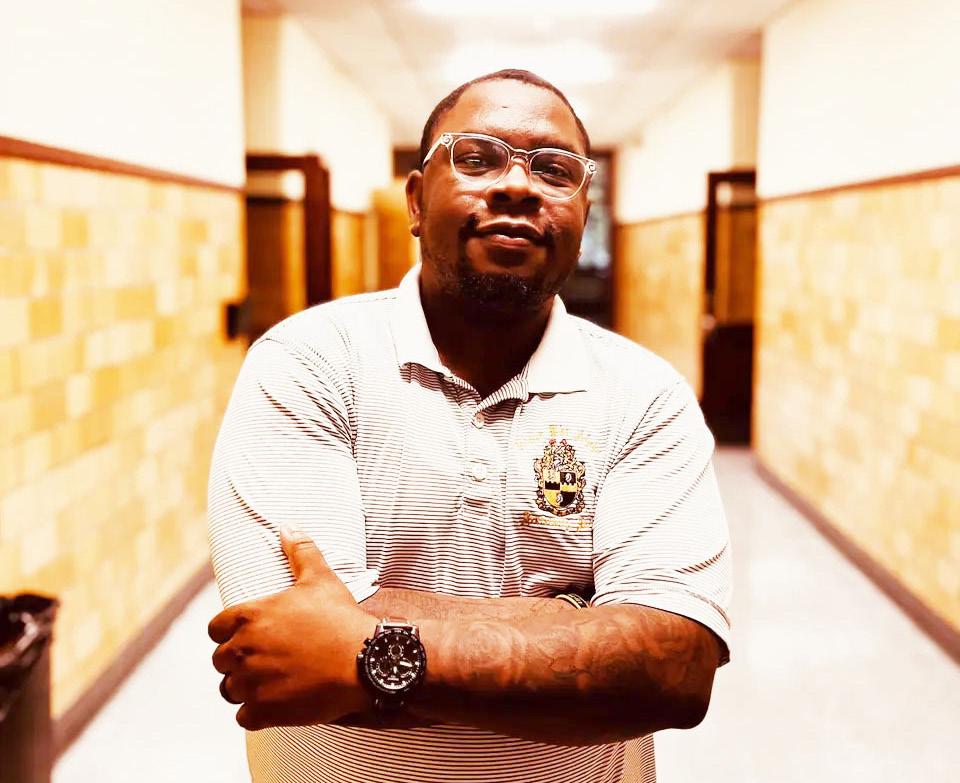
His LinkedIn profile states that he previously worked for the Achievement First charter school network in Rhode Island, and for KIPP Colorado Schools in Denver.
“We’re here to provide a physically and psychologically safe environment to engage with college prep, innovation, and SEL and a pathway to post secondary success and productive contributors to society,” he said.
The school’s funding sources include startup funding from Great Schools for Connecticut, which receives its funding from the federal charter school program grant.

John P. Thomas Publisher / CEO
Babz Rawls Ivy Editor-in-Chief Liaison, Corporate Affairs Babz@penfieldcomm.com
The bulk of the funding for the upcoming school year comes from the state’s per-pupil funding allocation. A smaller portion also comes from federal funding under Titles 1, 2, and 4.
“In the charter space, any gaps in funding require additional fundraising from private philanthropy,” Taylor said. “The school was able to acquire enough funding to make the budget work. Total cost for year one is approximately $2 million to serve 75 students in grade 5 and grade 6.”
He clarified that the school will receive no funding from New Haven Public Schools or from the City of New Haven.
Advertising/Sales Team
Keith Jackson Delores Alleyne
John Thomas, III
Editorial Team
Staff Writers
Christian Lewis/Current Affairs
Anthony Scott/Sports
Arlene Davis-Rudd/Politics
David Asbery / Tanisha Asbery
Jerry Craft / Cartoons / Barbara Fair
Dr. Tamiko Jackson-McArthur
Michelle Turner / Smita Shrestha William Spivey / Kam Williams
Rev. Samuel T. Ross-Lee
Contributors At-Large
Christine Stuart
www.CTNewsJunkie.com
Paul Bass www.newhavenindependent.org
National Association of Black Journalist
National Newspapers Publishers Association
Greater New Haven Chamber of Commerce
Greater New Haven Business & Professional Greater New England Minority Supplier Development Council, Inc.
The Inner-City Newspaper is published weekly by Penfield Communications, Inc. from offices located at 50 Fitch Street, 2nd Floor, New Haven, CT 06515. 203-3870354 phone; 203-387-2684 fax. Subscriptions:$260 per year (does not include sales tax for the in State subscriptions). Send name, address, zip code with payment. Postmaster, send address changes to 50 Fitch Street, New Haven, CT 06515. Display ad deadline Friday prior to insertion date at 5:00pm Advertisers are responsible for checking ads for error in publication. Penfield Communications, Inc d.b.a., “The Inner-City Newspaper” , shall not be liable for failure to publish an ad or for typographical errors or errors in publication, except to the extent of the cost of the space in which actual error appeared in the first insertion. The Publisher reserves the right to refuse advertising for any reason and to alter advertising copy or graphics deemed unacceptable for publication. The entire contents of The Inner-City Newspaper are copyright 2012, Penfield Communications, Inc. and no portion may be reproduced by any means without the written permission of the publisher. 10

by Rev. Hiram L. Brett
“Faith Matters” is a column that features pieces written by local religious figures. (Opinion) “Which of these three, do you think, was neighbor to the man who fell into the hands of the robbers?” He said, “The one who showed him mercy.” Jesus said to him, “Go and do likewise” (Luke 10:36 – 37 NRSV)
The preceding bible verse is the closing lines to one of Jesus’ most famous parables, which has become popularly known as the parable of the Good Samaritan. The parable depicts an exchange between a lawyer and Jesus. Seeking to test Jesus, the lawyer begins by asking Jesus what he must do to inherit eternal life. Jesus does not answer him directly but instead asks the learned lawyer, what does the law say? The lawyer replies by reciting the Shema, the most important prayer in Judaism: “Love God with all your heart, soul, strength and mind; and love your neighbor as yourself.” Our lawyer, not satisfied with the exchange, asks a follow-up question: “Who is my neighbor?” Jesus replies with the parable of the Good Samaritan. In the parable, a man is stranded along the road from Jericho to Jerusalem after being accosted by some robbers and left beaten, distressed and half dead. As he lay there, two men (a priest and a Levite, both high ranking officials who are his brethren) pass by him without stopping. It is only the third man, a Samaritan (an outcast and someone looked down upon), who crosses the road to help the fallen man. Not only does he help the fallen man to an inn to tend his wounds, but he pays for the man’s care and attention.
I think this parable resonates so deeply with me because once while running the New Haven Road race, I was incapacitated along the route and no one crossed the road to inquire about me or to assist. In the case of our fallen man on the road to Jerusalem, two high ranking and important members of society for various reasons chose not to cross the road to help the fallen man. It was the outcast who dared to cross the road and, in doing so, exhibited mercy and showed what it is to be a neighbor. Jesus tells the lawyer (and by extension us) to go and do likewise.
What are the roads that you will not cross?
What are the roads that you have not crossed?
What are the roads that you are afraid to cross?
Dr. Martin Luther King, Jr. in referring to the trait shown by the Samaritan describes it as altruism which the dictionary defines as regard for and devotion to the interests of others. The Samaritan had made concern for others a primary characteristic of his life. Dr. King indicates that the Samaritan illustrates three dimensions of altruism: universal, dangerous, and excessive. Universal in that he was able to look beyond the exterior (religion, race, status, nationality) of the suffering man. Dangerous in that he risked his own person in going to attend to attend to the man. The road from Jerusalem to Jericho was a dangerous road and for all he knew, he could be walking into a trap. Finally,
it was excessive in that the Samaritan not only tended his wounds but he took him to shelter and left money to pay his bill. Certainly, this was a radical display of altruism.
To fully live into the beloved community, we must be willing to see our neighbor and cross the road to share our common humanity. As we look around, we can see many behaviors that blunt that effort. In our Congress, we see politicians who are unwilling to cross the road to protect rural hospitals and maintain support for vulnerable families and students. Is anyone willing to cross the road? In our cities, we see citizens unwilling to address the poverty, mass incarceration, homelessness, and gun violence that is all too commonplace. Is anyone willing to cross the road? In our personal lives, we see pride, an unwillingness to forgive, bias, jealousy and prejudice as barriers to us fully loving our family member, colleague, and neighbor. Is anyone willing to cross the road?
In a time of increasing moral deregulation, (a rolling back on civic and ethic norms and a breakdown of moral norms and values), the admonition to cross the road to show mercy, to exhibit radical altruism; yes, to practice radical love is a force multiplier in our quest for the beloved community. Love is the most powerful force in the world, if exercised. As Rumi states, “love is the bridge between you and everything”. As you traverse your life’s path, I invite you to consider these questions:
Having then pondered, let love propel you forward over the bridge and across the road to embrace your neighbor.
Reverend Hiram L. Brett is spiritual care coordinator and chaplain at Connecticut Mental Health Center (CMHC) and serves as co-chair of the Committee on Ministry (COM) for the New Haven Association of the United Church of Christ. His ministry encompasses providing chaplaincy services to marginalized and vulnerable patients and families.












































by Maya McFadden
Hill Central, Edgewood School, and High School in the Community will all have new principals this school year thanks to a leadership shuffle that took place two weeks before the start of the 2025 – 2026 academic year.
Those personnel transfers were presented to the Board of Education during its latest biweekly meeting, which was held online via Zoom and in person at King/Robinson School.
The following transfers are effective as of Tuesday:
• Nicole Brown will go from being Hill Central’s principal to Edgewood School’s principal;
• Nicholas Perrone will go from being Edgewood School’s principal to helming High School in the Community;
• Kimberly Daniley will go from being the principal of the now-closed Brennan-Rogers School to the principal of Hill Central;
• Cari Strand will go from being the principal (or building leader) of High School in the Community to a new itinerant position titled Career & Technical Education (CTE) Lead.
There were also a total of 21 teacher transfers and six paraprofessional transfers included in Monday’s personnel report, which was information only and did not require a vote from the board.
Reached for comment Tuesday, Nicole Brown told the Independent, “For the last fifteen years, the Hill Central family has been a source of pride and joy where students learn and thrive. I look forward to joining the Edgewood Community to build upon the positive, familial environment
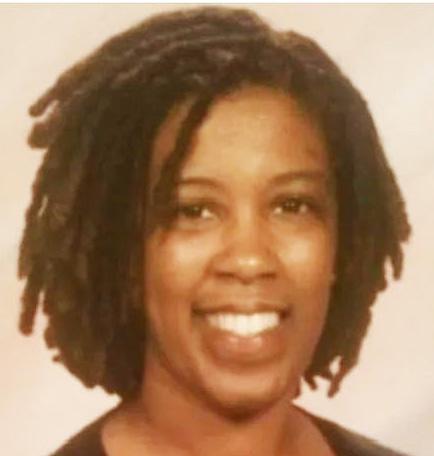
while bringing a focus on joy, academic rigor and inclusivity.”
In a separate interview, Cari Strand recalled starting at HSC in 2009 as an itinerant Dual-Credit Specialist (then called ISSP Coordinator) and then moving up the ranks to a magnet resource teacher, curriculum leader (assistant principal) in 2015, and building leader in 2021.
“I’ve loved every role I’ve had at the school and leaving is certainly bittersweet. I’m most proud of hiring an incredible team of teachers and maintaining a strong teacher retention rate, as I’ve been lead on that for the past ten years,” she said. “At HSC, the faculty works hard, but everyone takes care of each other so that they have the energy, capacity, and resources to do their best for the students.”
She said her goals going into the new role, which she applied for, will be to expand on the impact and focus she had at HSC, which was “to ensure that students left with the skills and knowledge they
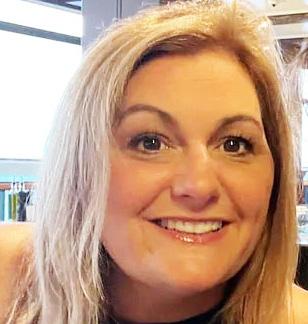
needed to define and determine their own futures.”
In her new role, she said she will work with Career and Technical Education (CTE) teachers across NHPS high schools as the team works to prepare students for day-to-day work experiences after high school. Her hope is that strong CTE classes “can have positive impacts on attendance, graduation rate, students’ sense of belonging, and more.”
Nicholas Perrone, meanwhile, told the Independent Monday that, while it is difficult to leave Edgewood’s “incredible school community,” he’s inspired to dive into HSC’s school themes.
“Essentially, it will be important that the [HSC] school community know that my intention is not to come in and make sweeping changes,” he said. “The themes of HSC are what inspire me the most; these ideals will carry the work and keep the focus to empower student leadership and vision. Professionally, I am super excited for

the opportunity to learn and lead alongside the school community. The funny thing is that we were already working on a partnership between the two schools where the HSC WILD student leaders were going to help lead and facilitate an overnight trip for our Edgewood grade 6 – 7 students this fall. We still hope to make that happen, and I will be thrilled to witness this partnership come to fruition.”
Click here to read Perrone’s letter to Edgewood’s community in which he notes moments over the past six years of his leadership that he’s most proud of. Those include growing the school’s ECHO program, improving attendance numbers and academic scores, hosting three Chinese teaching fellows from Yale for a language program for students, and developing a guest artist program. He also described a few of his regular “bad jokes” and a reminder he will stay in contact with Nicole Brown as new principal.
Perrone also shared with the Independent

the following drafted remarks he planned to give at Monday’s school board meeting: “It is an honor to formally accept this appointment. First, to my Edgewood school family, you are an incredible community that embraces the importance of diversity and identity. As a parent, I am excited to witness the ways in which the school will continue to grow. As I said every morning, ‘make sure to grow a little more today.’ And to the members of High School in the Community, during a time of political uncertainty and downright fear for what our government will do next, this is an amazing opportunity to help empower the voices of our younger generation to serve, to design policy, to push for justice, and to lead our world in a brighter and better direction. It is my pleasure and honor to learn and lead alongside this vibrant school community that values student leadership, social justice, public policy, and service. Thank you.”
by Jamil Ragland
HARTFORD, CT — As the Trump administration continues to overhaul federal spending and disbursements to the states, Connecticut officials are stuck in a holding pattern, trying to make their dollars stretch further.
The appropriations, human services and public health committees convened at the Legislative Office Building last week to hear from commissioners of the Department of Mental Health and Addiction Services (DMHAS), Department of Children and Families (DCF), Department of Public Health (DPH), and the Department of Social Services (DSS) regarding their plans for the use of federal block grants in the upcoming fiscal year.
Nancy Navarrett, commissioner of DMHAS, called for flat funding a pair of grants the department oversees.
The substance use block grant provides funds to states to develop effective alcohol, tobacco and other drug use prevention treatment and recovery services.
The department also partners with DCF on the community mental health block
grant, which funds mental health services for adults with serious mental illness. A portion also is shared with DCF to provide services for children with serious emotional disturbance.
“The funding this block grant provides is extremely important to community-based providers across the state as they work to support our shared mission of developing community-oriented, cost-effective services that allow individuals to be served in the least restrictive and most appropriate setting available,” Navarretta said.
Public Health Commissioner Manisha Juthani said programming funded by the block grants would not be affected by the flat funding, but did say that the future of some of the funding remains in doubt.
The preventative health and health services block grant supports chronic disease prevention in areas regarding asthma, cancer, cardiovascular disease, diabetes, smoking cessation, injury prevention, suicide prevention, and sexual assault crisis programs. Juthani said the funding is also used to support the Office of Policy and Strategic Initiatives. The allocation plan calls for flat funding in 2026, at a little

over $2.4 million.
As its name suggests, the $4.8 million maternal and child health services block grant supports services that address critical maternal and child health needs. The funds are used to help ensure that high-
risk pregnant women, children, and families across Connecticut receive services such as care coordination, screenings, and community-based support, Juthani said.
“In terms of the Preventative Health Services block grant, more than half of that grant goes directly to our local health departments to provide programming at the local level to support local prevention efforts, specifically on chronic disease prevention,” she said. “And that is particularly potentially vulnerable as we go forward. The president’s budget eliminates this block grant, so we will have to address that if that happens in the next federal fiscal year.”
Social Services Commissioner Andrea Barton Reeves said the community services block grant supports low-income individuals and families. The allocation plan calls for a budget of $9.2 million to support programs such as case management, energy assistance and weatherization, the Low Income Heating and Energy Assistance Program (LIHEAP), food and nutrition services, and housing and shelter programs.
Deputy Commissioner Peter Hadler
described the social services block grant, which helps people achieve economic self-sufficiency and prevent or remedy neglect, abuse, or exploitation of vulnerable groups. The income eligibility for people served by the block grant is 150% of federal poverty guidelines, or about $48,000 annually for a family of four.
While the grant funding is expected to remain flat at $17.2 million, the DSS allocation plan calls for $19.2 million to be appropriated, using $2 million in one-time use carry forward funds. Reeves said the use of the carry forward funds was intended to “smooth the gap” as DSS transitions programing back to pre-pandemic levels of funding.
“We completely understand and appreciate that that means that there would be a reduction in the number of meals that we would be able to serve,” Reeves said, referring to DSS nutrition programs. “But we really don’t have any other resources at this point given our proposed allocation plan that we could substitute that for. So we did have to make the decision to move that back to the pre-pandemic dollars, as we have.”

Lucy Gellman, Editor, The Arts Paper newhavenarts.org
Over 100 people closed their eyes across the New Haven Green as Kirill Staklo gripped a mic, and lifted it to his mouth. “If you are somebody or love somebody whose life was saved by gender-affirming care,” he said, “raise your hand please.”
A few dozen hands went up. Then a dozen more. Within seconds, it was close to 100. Breath rose and fell over the Green. Buses rolled by on Chapel Street. In the crowd, a sign that read Shame On YNHH in pink and green letters caught in the afternoon light and glowed. Mason Angkapatyakit, a rising senior at Metropolitan Business Academy, soaked in the moment.
“Now open your eyes.” Attendees looked around, some already fighting back tears, like they were seeing something for the first time.
A rallying cry for gender-affirming healthcare—particularly and urgently for trans youth—blanketed the Green Thursday afternoon, as over 100 people called for its swift and permanent reinstatement at Yale New Haven Health and Connecticut Children’s Hospital, and a stronger commitment from the state to protect trans people and provide them with the healthcare they need.
That includes, organizers said, a reassessment of the state’s fiscal guardrails to extend healthcare coverage to those who may lose it in the next year, in the wake of Donald Trump’s massive spending bill.
It comes just two weeks after Yale Medicine and Yale New Haven Health sent a letter to parents and families in its Pediatric Gender Program that it would no longer provide gender-affirming care to youth aged 19 and under. That includes, for instance, hormone replacement therapy and puberty blockers—medically sound, rigorously studied approaches that have a direct correlation with improved mental health outcomes and significantly reduced chance of self-harm.
In over an hour, activists, educators, healthcare workers, artists and labor organizers all noted that such care isn’t just lifesaving: it’s tied to the wellbeing of all people, and of democracy itself.
“For those with the people in your lives that don’t care about trans rights specifically because they feel like there are bigger things to be concerned about: trans people have always been the canary in the coal mine,” said Staklo, a founding member of Trans Haven and the Connecticut branch of the Party for Socialism and Liberation (PSL). “Whenever they’ve started discriminating against us legally, it started a long line of discrimination and abuse against other working-class people. That’s always been the case.”
Capitulating to the Trump Administration does not work, he added. At the time it sent the letter, Yale Medicine maintained that the decision, which it called a difficult one, was in keeping with the Trump Administration’s crackdown on LGBTQ+ rights and its executive orders
restricting access to gender-affirming care. In the days and weeks since, Connecticut has joined 17 states, as well as the District of Columbia, in suing the Trump Administration over the decision.
“The attack on trans youth is an attempt to foreclose the possibility of trans life," said Eric Maroney (top photo), an English instructor at CT State Gateway and a member of the American Federation of Teachers or AFT. Long before he was an educator, Maroney said, he was a young trans kid, receiving vital care at Connecticut Children’s.
“Yale New Haven has the economic resources to fight back against the Trump Administration, and they’ve decided not to do so,” chimed in fellow PSL member Sam Morrison, who is studying social work at Southern Connecticut State University. “They’ve decided that trans people are disposable. They’ve decided that trans people do not deserve protection.”
As the afternoon cooled on the Green, speaker after speaker stressed the need to understand that gender-affirming care— which is “not difficult care,” said Dr. Liza E. Goldman Huertas emphatically—is often a lifeline, the thing that stands between a young person and the life-threatening physical and psychological harm that gender dysphoria, depression, bullying, and emotional isolation can create.
In 2024, the Trevor Project reported that 39 percent of LGBTQ+ young people (which the organization defines as ages 13 to 24) “seriously considered attempting suicide in the past year,” according to a national survey on the mental health of LGBTQ+ young people.
Within that 39 percent, roughly half were transgender and nonbinary youth. What helped change outcomes, consistently, was a supportive environment and access to gender-affirming care, from mental health resources to medical intervention to delay puberty or start HRT.
Layne Alexander Gianakos, a healthcare training manager at Planned Parenthood of Southern New England, remembered being one of those young people 15 years ago, when he was 17 years old. At the time, Yale New Haven Health didn’t yet run a formalized pediatric gender program—but the institution did have an endocrinologist who listened. It saved his life.
“I was that kid,” Gianakos said. By the time he was 17, Gianakos had already tried once to end his life. He was afraid of what the future might hold. “I wanted to be a person, not a policy,” he remembered. “Not a petition.” Then he accessed gender-affirming care for the first time.
It transformed his life. It also kept him alive. Now, Gianakos said, he’s afraid for youth who suddenly don’t have access to that care, particularly those who were at the beginning of their journeys. He knows firsthand that more than 40 percent of trans adults have tried to end their lives. He wants a different reality for the next generation.
“That’s a stack of unsent college applications,” he said, and some attendees who
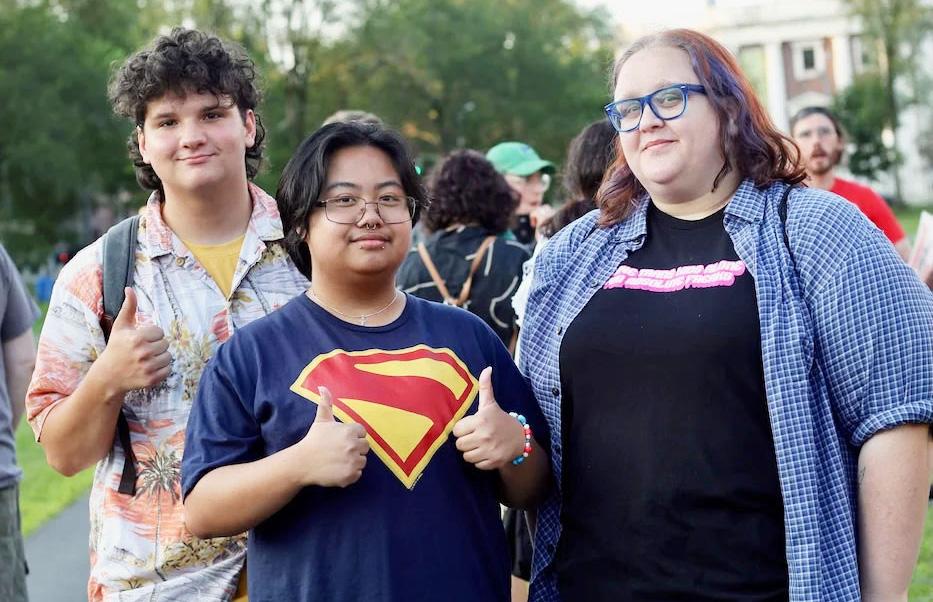
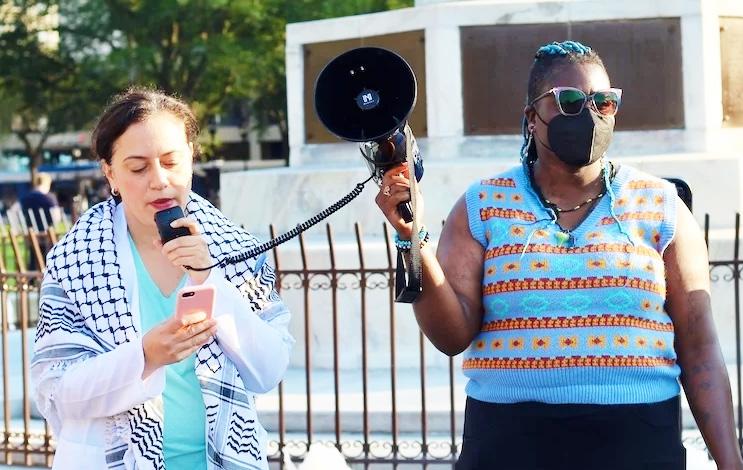
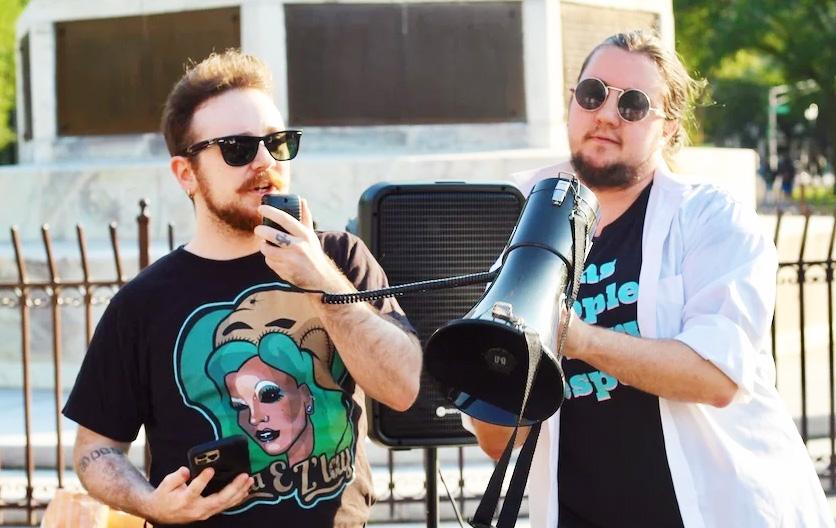
had been trying not to cry let the floodgates open up. “That’s a bedroom your kid didn’t leave … someone is out there who needs the care that I had.”
That message echoed for Erin Michaud, a visual arts instructor at Cooperative Arts & Humanities High School who has taught in the New Haven Public Schools for 25 years and is a proud member of the New Haven Federation of Teachers. As they spoke, the words “There Are LGBTQ+ Artists Among Us” peeked out in black and pink text from their shirt.
“We are here today because we love our
ularly Black and Brown trans women, have always played in social movements. As they spoke, many balanced their own comments with chants of “One-twothree-four! Open up those clinic doors! Five-six-seven-eight! Stop the lies and stop the hate!” and “When trans rights are under attack what do we do? Stand up fight back!”
The co-founder of The Children of Marsha P. Johnson and a longtime organizer and educator with City Wide Youth Coalition and the New Haven Pride Center, Alyssa-Marie Cajigas Rivera Ortiz urged attendees to advocate for trans youth, in part because their own safety remains tied to the safety of queer and trans people of all ages. For many young people, she explained, gender-affirming care isn’t just helpful, it’s literally a matter of life and death.
Or in her words, “a door to their survival is slammed shut.”
“This is calculated, state-aligned, Christian nationalist fascism, and it puts our youth in direct danger,” she said. “What Yale has done isn’t about standard of care, it is about appeasing the growing far right movement that is sweeping this country. A movement that tells our babies they don’t deserve to live, to thrive, to be seen, to be loved, and we will not sit by while they drag our children into the shadows.” She, like many of the evening’s speakers, also tied the fight for gender-affirming care to a larger movement defined by the belief in public goods and services—that all people deserve access to healthcare, housing, and education because those are basic and fundamental human rights. She invoked the legacy of movement bearers like Marsha P. Johnson, a Black trans woman who helped lead the Stonewall riot. Cajigas Ortiz reveres these women, “who dared to be divine in a world that tried to kill them,” because they teach her how to resist.
“When Black trans women organize, we don’t just demand inclusion, we demand transformation,” she said. “We don’t just want a seat at the table. We want to burn that table down and build a new one where no one gets left behind.”
students,” Michaud began, and there was a smattering of cheers from the crowd.
Calling on city and state elected officials (including, presumably, Mayor Justin Elicker, who attended the event), they pointed to students’ need to feel safe, cared for, and accepted in and beyond the classroom, without which they cannot learn. If they don’t feel able to express themselves, Michaud said, how can they be expected to thrive in school?
“We do not get to pick and choose which students deserve dignity,” they said. Throughout the evening, others also pointed to the role trans people, partic-
As they listened nearby, Timothy Brown and his five-year-old daughter, Grayson, let the words wash over them. As a cis person and a dad, Brown said, he saw it as his responsibility to come out and support trans youth—and all trans people— on Thursday.
He doesn’t yet know who Grayson is going to be, or how she might identify, he said. But he wants her—and all children—to have access to the care that they need to live full, enriching and healthy lives.
“This is a violation of anti-discrimination laws in the State of Connecticut,” he said of the sudden closure of the pediatric gender program. “We are here to stand up
for the rights of all trans people, but especially trans kids.”
Grayson kept the message more simple. As she prepared to listen, wearing a rainbow-colored scarf and shiny headband, she held up a handmade sign that read “Don’t Bully People.” It was really that straightforward.
“It Still Feels Awful”
In late July, 17-year-old Mason Angkapatyakit was one of those young people to receive a letter from Yale Medicine and Yale New Haven Health. At first, he said, he didn’t know what it was—in part because it was addressed to his deadname. Then the reality of what was happening began to sink in.
“I consider myself on the luckier side, because I’m, like, over a year into my medical transition,” said Angkapatyakit, a rising senior at Metropolitan Business Academy. “But it still feels awful that I can’t be on hormones anymore because Yale just decided, ‘No, we’re scared.’”
Angkapatyakit started hormone replacement therapy two years ago, a decision he came to after coming out to his friends in middle school, and his family thereafter. He was on the cusp of getting top surgery, a procedure that can be life-changing for trans people still struggling with gender dysphoria. When he read the letter, he felt “that awful despair,” like a rug had been pulled out from under him.
“I was already on testosterone,” he added. “For those people who were going to be on HRT and that was cut off for them—they have to wait for multiple years now—it’s just unreasonable. These people need support. Give them support instead of shaming them! Like, what are you doing?”
Being trans isn’t just a phase, he added: it’s been a whole journey, filled with deep self-reflection. As a kid “I just went through life thinking I was a tomboy,” he remembered. But that didn’t feel completely right. When he was around six years old, Angkapatyakit saw a video about penguins that made him think differently about sex and gender. He still didn’t quite have the words for it, but felt that he was inching towards something.
“When I was 11, I was like, ‘Okay, I think I’m a dude,’” he remembered. He came out to his friends, and then his family. He changed his name. When he started testosterone two years ago, “I was elated,” he said. His first appointment in the clinic was on the first day of school, in what felt like a year of new beginnings.
In the weeks since, he has started to think about his next steps, including where he’ll receive gender-affirming care going forward. He’s started hearing about Anchor Health and is hopeful, he said— but also doesn’t think he should have to make that pivot at all.
“It’s kind of ridiculous for Yale to be like, ‘Oh, we can’t do it anymore,’” chimed in Jessie Simpson, who teaches history, psychology and law at Metro and leads the school’s Gender-Sexuality Alliance (GSA). When she heard about the rally Wednesday night, she sent the flyer to Angkapatyakit. There was no question in her mind that she would come out to support.
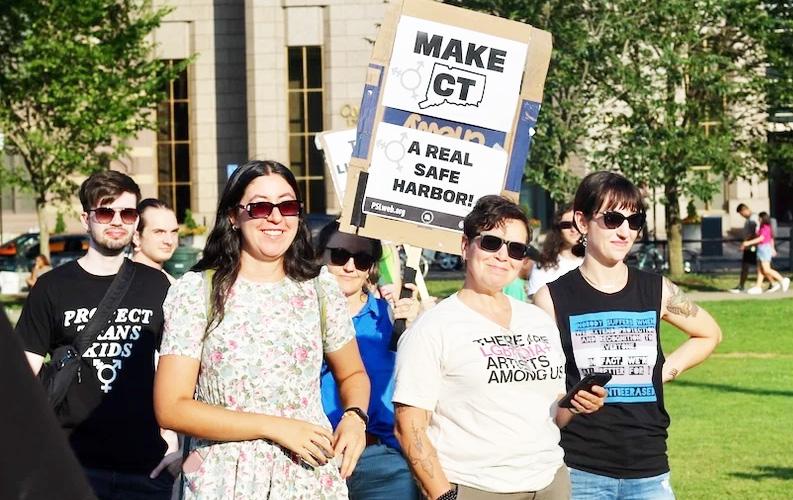


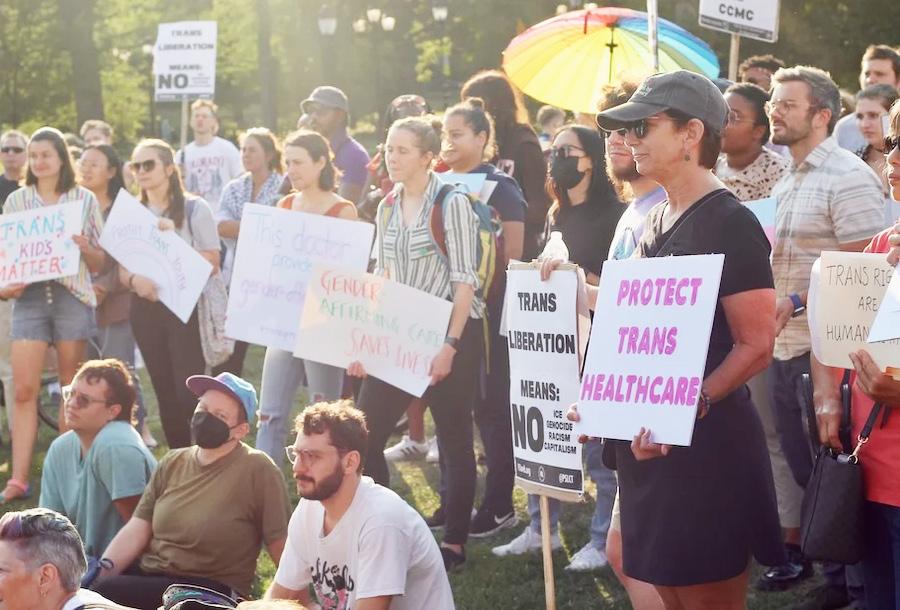

•
•
• Ask us about My Account and our Energy Analyzer tool.
by Laura Glesby
Incumbent Fair Haven Alder Jose Crespo showed up as a guest Friday at his challenger’s press conference and joined a who’s who of politicos supporting her.
That was the surprise twist at a press conference held by Ward 16 alder candidate Magda Natal.
Crespo won the Democratic Party’s endorsement to run for a sixth term for the seat. Natal petitioned her way onto the ballot to challenge Crespo in a primary then began racking up endorsements.
State Rep. Juan Candelaria emceed her press conference Friday outside the elderly housing complex 25 Saltonstall Ave. He was joined by State Sen. President Pro Tempore Martin Looney; State Rep. Al Paolillo; a slate of former, current, and aspiring alders in the Hill and Fair Haven; Democratic Party Town Chair Vin Mauro; and labor advocates with the New Haven Federation of Teachers and New Haven Rising.
“I know that what I am stepping into is not something to be taken lightly,” said Natal. “I’m here to learn as I am in service. There are a lot of things that many of you can mentor and guide me on.”
The event had originally been planned around Candelaria’s endorsement before Crespo announced his resignation from the race. Crespo, an incumbent Democrat who has represented Ward 16 on the Board of Alders for five consecutive two-year terms, had received the formal endorsement of the Democratic Party on July 21; Friday’s press conference marked a shift in establishment support toward Natal in the weeks since.
Candelaria and other speakers pointed to Natal’s track record of working with young people, not only as an English language teacher at Wilbur Cross High School but as a co-organizer of the annual


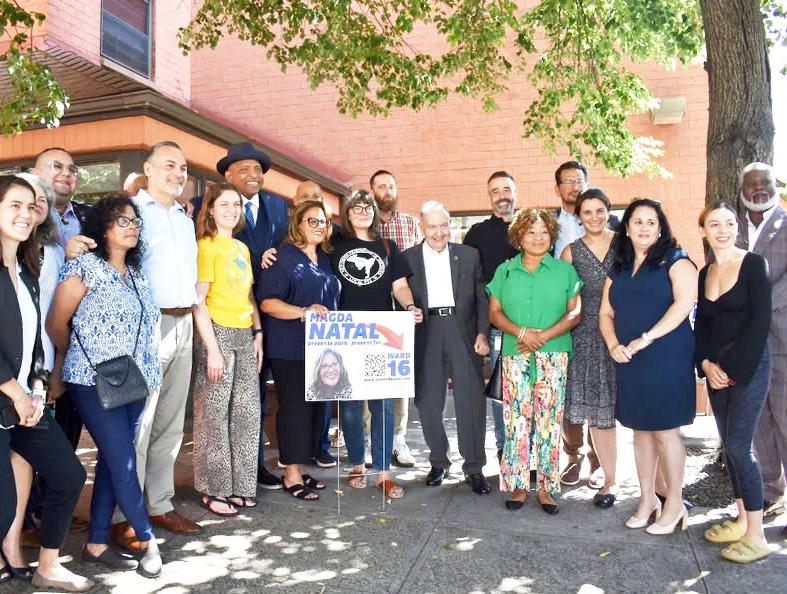

by Thomas Breen
There won’t be a Democratic primary in the Ward 16 alder race after all now that Fair Haven Alder Jose Crespo has formally withdrawn his candidacy, leaving challenger Magda Natal unopposed in her pursuit of the Democratic nomination for the role.
At 4:55 p.m. Friday, Crespo a ten-year incumbent who had secured the Democratic Town Committee’s official endorsement in July sent an email to City Clerk Michael Smart with the subject line, “Request to Remove my Candidacy for Alder of Ward 16.”
“Please allow this email to serve as my official notice of my request to

remove my candidacy for the primary and general election for the position of alder for the 16th ward,” Crespo wrote in that email.
“I have been honored to serve this great community for 10 years and I’d like to take this time to focus on my education as I will be starting my Masters level education in two weeks and I’d like nothing but the unity of our residents in Fair Haven and I will work alongside the community and elected officials to ensure the best interest of our community is met!”
Crespo sent that email hours after he showed up as guest at a press conference hosted by his challenger, Magda Natal, and announced that he would not be seeking reelection after all, and
Big Turtle Village summer camping trip for Fair Haven children.
Natal “has been a strong advocate for our children as a teacher of English as a second language,” said Candelaria. “She’s somebody every day that leads with that love and compassion for students,” said Paolillo.
Crespo said in a speech that “it’s been such an honor and a pleasure” to serve as alder for the last ten years. “Fair Haven united is better than a Fair Haven divided.”
While Crespo clarified after the press conference that he is ending his run for reelection, his name will still technically be on the ballot for the Sept. 9 primary election.
Meanwhile, in the Nov. 4 general election, Natal will face Independent Party candidate Rafael Fuentes.
Crespo elaborated after the event that he decided to drop out because “I understand that victory is not as sweet if there’s division in the community. There’s too much division going on.”
He said he plans to focus on pursuing his MBA at Albertus Magnus College this fall. Asked what he’s most proud of achieving over the last ten years, he pointed to his advocacy for a Latino-focused charter school through his employer, CT LEAD.
Natal’s campaign comes two years after Frank Redente unseated another longtime Fair Haven Alder, Ernie Santiago, in Ward 15. Two other alders with slivers of their ward in Fair Haven, Ward 8 Alder Ellen Cupo and Ward 13 Alder Rosa Ferraro-Santana, are not running again for reelection meaning that a tide of new leadership is coming to Fair Haven. Redente said the group forming “Team Fair Haven” on the Board of Alders which he hopes will soon include Natal is working to change neighborhood politics to prioritize cooperation and collaboration. “Fair Haven alders have never worked together,” said Redente.
would instead be supporting Natal’s candidacy.
During an interview at that presser, Crespo said that his name would still appear on the ballot of the Sept. 9 Democratic primary even though he was dropping out of the race. Friday’s email, however, means that he won’t actually be running in September. And, since Natal is now uncontested in her pursuit of the Democratic nomination for Ward 16 alder, there will not actually be a Democratic primary. Instead, Natal will simply be the Democratic nominee on the Nov. 4 general election ballot, where she’ll face off against Independent Party challenger Rafael Fuentes.
Alder Sarah Miller, who represents Fair Haven’s Ward 14, said that the Fair Haven alders are also looking to collaborate with their colleagues in the Hill on advocating for state-level reforms affecting their communities. She noted that the Hill and Fair Haven face similar challenges, such as public substance use and crime-attracting businesses.
Natal said that her campaign chose to announce the endorsements outside the elderly housing complex at 25 Saltonstall in part because she had spent many evenings knocking on doors in that building. She said that residents had conveyed concerns about wheelchair accessibility, healthcare costs, and repairs needed in their apartments.
And she recalled a pervasive skepticism toward politicians from the building’s residents. “There’s this sense that we come, we show up for their vote, and we leave,” she said. She sought to hold the press conference there because “I want to come back.”
“They’ve gotten ignored for a long time,”
added.

Lucy Gellman
An economic development summit that centers Black voices, and celebrates the growth they have enabled in New Haven. A mixer for Black businesses, with arts and culture that are vibrant and alive enough to match the conversation. A daylong festival on the New Haven Green, where over 200 Black vendors, artists and entrepreneurs are the heartbeat of the day’s festivities.
All of those are coming to New Haven this week, as the Black Wall Street Festival (BWS Fest) returns to the city for the fourth summer in a row. Organized by The Breed Ent. and the city’s Department of Arts, Culture & Tourism with several collaborators, this year’s event features an economic summit at Southern Connecticut State University (SCSU), an entrepreneur party Friday night, and an eight-hour festival on the Green to kick off the weekend. The main event takes place this Saturday, August 16; a full website of events is available here. The timing falls during both Black August, a decades-deep celebration of Black revolutionaries, and National Black Business Month, as well as in a summer of downtown festivals that has also included Seeing Sounds, New Haven Open Streets and the Puerto Rican Festival.
The Breed is the mellifluous brainchild of Aaron “Y.A.” Rogers and Rashad “Snacks” Johnson, Grammy-winning artists and music producers who founded the company in 2009, and added its not-forprofit arm, The Breed Academy, in 2020. Both grew up in New Haven; both stayed in part to make a difference in the place that raised them.
“From the beginning, we've done everything from the ground up,” Rogers said at a press conference Monday morning on the Green. “So I think naturally, we just adapted that to the Black Wall Street Festival. It's about instilling confidence in Black businesses, that you don't need any help other than your community to do what you need to do. We're empowering them and educating them and letting them know that we all have each other.”
This year, that begins on Thursday afternoon, as Communities for Generations, Inc. (CFG) hosts its third annual economic development summit, “The Audacity to Build” at the Adanti Student Center at SCSU. Held over an action-packed four hours at the university, the event includes multiple panels and workshops around community resource sharing, from Black business founders like Rashaan Boyd, Kristen Threatt and Renee Brown to a keynote from Kebra Smith-Bolden, the founder and general manager of LIT New Haven.
One panel, for instance, features Erik Clemons, Howard K. Hill and Karen DuBois-Walton in a discussion around creating wealth and power within the Black community that can last for generations to come. Another, from former State Rep. Robyn Porter, offers a “live strategy lab” where people can gather, connect, and bounce ideas off of both each other and professionals in the field. While the sum-

Sienna McLean and her mom, cultural affairs commissioner and BLOOM owner and founder Alisha Crutchfield. The "Black Girls Are Sunshine" design is a nod to artist-entrepreneur and poet Sun Queen, who founded the brand several years ago.
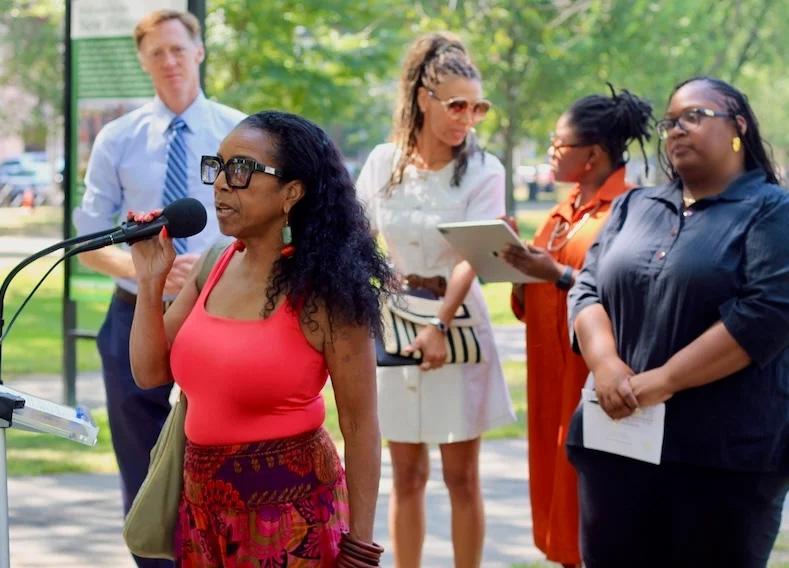

mit is now in its third year, it is the first that Communities for Generations has worked with BWS Fest.
“We’re grateful to be able to extend our reach to our younger generations, who need to pick up the torch to let our seniors rest in this civic engagement space,” said Arden Santana, director of educational programs for the organization. “And we can do that through Black Wall Street’s support with that people power.”
“I feel like this is a movement,” added Hafeeza Turé, director of Health & Wellness Initiatives at the organization. The night will also honor several awardees, including Stetson Branch Manager Diane Brown, who carried the Elm City Freddy Fixer Parade through multiple iterations; CPEN founder and Newhallville booster Doreen Abubukar; Newhallville Fresh Starts founder Marcus Harvin; More Amour Boutique owner Kim Poole; the LAB at ConnCORP Director Jahkeeva Morgan; and Kobéy Enterprises’ Kobéy Smith.
On Friday, BWS Fest continues with an entrepreneur party at the Canal Dock Boathouse, with both networking and a
performance from the R&B artist Vedo. Then on Saturday, the main event begins at noon on the New Haven Green. In addition to vendors, the day-long fest will have family-friendly activities, food vendors, and several artists on the city’s stage, just as it has in years past.
This year, organizers are expecting over 250 vendors and over 10,000 people, said Mayor Justin Elicker. Shouting out the small Black-owned businesses that make New Haven a more vibrant place to live, he pointed to the high return on investment that comes from supporting local entrepreneurs.
Often, those business owners live and work in New Haven, meaning that the dollars they earn go right back into the city they call home. Sometimes, that’s much bigger than a financial transaction: vendors in past years have included artists, activists, mental health practitioners, and social service providers. All of them make New Haven into the city that it is.
“It’s a testament to the work that so many people behind me are doing to make sure that we support Black-owned businesses in New Haven,” Elicker said, tying the city’s support for Black Wall Street to a wider investment in inclusive growth.
“And we ensure that New Haven’s pride
in the twentieth century. Between 1900 and 1970, many of those became the targets of devastating violence at the hands of white people.
While the most well-known example may be the Greenwood neighborhood in Tulsa, Oklahoma, which in 1921 was burned to the ground by a white mob, there are several others: Oscarville, Georgia; South Durham, North Carolina; a self-sustaining section of Birmingham, Alabama where Klansmen bombed the 16th Street Baptist Church, killing four young Black girls, in 1963.
Partly because of that history, “it’s a duty” to show up and support Black vendors, organizers and artists on Saturday, Santana said in an interview after the press conference.
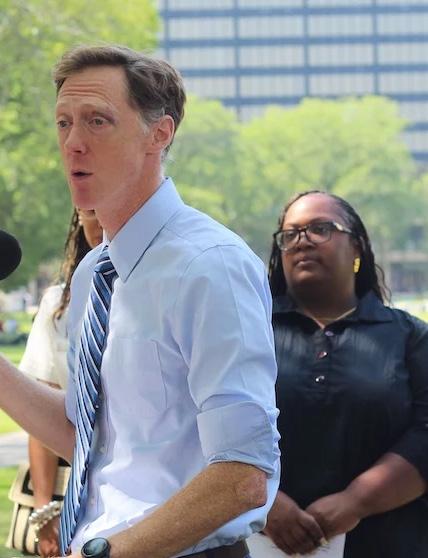
in our cultural diversity is on display for everyone to enjoy.”
Nothing has happened in a silo, Rogers and Johnson added in a conversation after the press conference. Four years ago, it would have been impossible to launch the event without city support, and particularly former Cultural Affairs Director Adriane Jefferson. At the time, it was still in Temple Plaza, with 35 vendors and a single day of activities. That afternoon was so successful that there was the momentum to repeat it the following year on the Green.
Since that time, the list of collaborators has grown, with partners like the New Haven Equitable Entrepreneurial Ecosystem (NHE3), ConnCAT and its for-profit subsidiary, ConnCORP, and the Center for Inclusive Growth. So has the festival’s footprint, from 150 vendors in 2023 to over 200 last August. For the first time last summer, the festival itself was also the culmination of a week of events, including an artist showcase, film festival, investment summit, entrepreneur party and fashion show.
It’s also meant to be a reclamation. The term “Black Wall Street” references the history, often overlooked and undertaught, of self-sustaining Black business districts
As BWS Fest arrives in New Haven, its goal is also to foster some of the same community connection and mutual support that once enabled those neighborhoods to thrive. Johnson, who grew up in New Haven, said that’s one of his favorite parts of the day itself: he sees people reconnecting on the Green, sometimes after decades of drifting apart.
“I think it hits us the most when our families talk about how they haven't seen their friends from the 70s or the 80s, and they get to see them at an event that Aaron, Adriane and I created,” he said, smiling at the sun-soaked Green around him. Nearby, the stage from the city’s Puerto Rican Festival stood empty, the music and buzz from Saturday still an echo in the air. “Exactly,” Rogers added. “It’s a big cookout.”
It comes at a time when Black voices and Black people are under siege on a national level. Since taking office in January of this year, President Donald Trump has actively worked to attack diversity, equity, and inclusion (DEI) efforts in every sector of the American workplace and civic sphere, from loans to Black farmers and Black businesses to the teaching of Black history itself.
What undergirds that violence—the economic disinvestment in and disenfranchisement of Black communities—is the same kind of white supremacy that led to the destruction and erasure of Black Wall Streets across the country barely a full century ago. It has opened what some, like the scholar Nikole Hannah-Jones, have called “a new era of unchecked discrimination” in the U.S., levels of which may not have been seen since before the Civil Rights Act in 1965.
Diane Brown, who runs Black Urban Librarian Consulting, praised the festival as an antidote to that kind of erasure. Growing up in New Haven, “we had things for us by us,” she said. But “I’ve never seen anything of this magnitude.” As an elder in the community, she’s spent years working to foster intergenerational connections, from her transformative tenure at the Stetson Branch Library to her work with the Freddy Fixer Parade. She sees Rogers and Johnson taking up that mantle. “When you step back from the New Haven Green and you see a sea of Black people




by Staff Report
HARTFORD, CT — The U.S. Environmental Protection Agency’s (EPA) announcement that it is attempting to terminate the Solar for All grant program means that thousands of Connecticut households will no longer be able to access the financial assistance needed to convert their homes to clean, affordable solar energy, according to a statement from Gov. Ned Lamont.
The EPA notified the Connecticut Department of Energy and Environmental Protection (DEEP) last week that it is
immediately terminating the $62.45 million grant the state secured through the program last year. Reports indicate that other grant recipients have also been informed that their grants are being terminated.
“At a time when households could benefit from transitioning to solar energy now more than ever, the Trump administration is attempting to terminate a program that would lower energy costs for families and businesses while also delivering clean energy,” Lamont. “These funds belong to the taxpayers of Connecticut.
This action by EPA is unlawful, and we will be working with other states to counter this action.”
Attorney General William Tong said this was the latest example of President Donald Trump seizing funds intended to lower costs for American families to pay for tax breaks for billionaires.
cut children and help prevent abuse and neglect via training, communication and oversight. The department also provides mental health, behavioral and substance abuse services and oversees a foster care system.
“When I began my journey as a frontline social worker in DCF’s New Haven office, I would have never imagined the path my life’s journey has taken,” Hill-Lilly said in a news release. “It was with great humility that I accepted the nomination to become commissioner, and I am grateful for the trust and support Governor Lamont and his entire team had in me in leading what almost everyone refers to as the hardest job in state government.”
The department often faces scrutiny and criticism.
A recent audit of the department highlighted the risk of children in foster care, and the risk of children in foster care running away.
The department has also been pressured to provide information about its handling of a case in Waterbury, where a man was found to have been locked up in his home for more than 20 years. Officials recently met with some lawmakers behind closed doors to discuss those findings and what has changed in state laws and policies in the past 20 years.
“After a long career dedicated to helping people across Connecticut, I wish Commissioner Hill-Lilly the best, with gratitude for all she has accomplished protecting and aiding vulnerable communities and families,” said state Sen. Ceci Maher, D-Wilton. “Her national recognition for her detailed, meaningful approach to this work reflects the care and compassion she has shown throughout her time at DCF.”
State Sen. Jason Perillo, R-Shelton, also said Hill-Lilly has dedicated herself to helping and protecting Connecticut’s most vulnerable children for decades.
“This is often thankless work, but I know I speak for many across our state when I say ‘thank you’ for those many years of service in a variety of challenging roles at DCF while serving as a mentor to fellow DCF staff,” Perillo said.
Both Maher and Perillo serve on the legislative Committee on Children.
“These funds were passed by Congress to reduce carbon pollution and to save money for low-income families getting socked right now by utility bills,” Tong said. “We are evaluating all legal options in coordination with our multistate partners to protect Connecticut families and Connecticut funds.”
Katie Dykes, commissioner of the Department of Energy and Environmental Protection, said the EPA action cuts off funding for a program that helps resi-
Con’t from page 12
selling and vending and networking and communicating, it’s a powerful thing,” she said. “Especially for the younger generations to see. If it can happen here, it can happen in our daily lives. I just want to applaud them, because I know this is not an easy task.”
As one of the city’s cultural affairs commissioners and a small business owner herself, BLOOM founder Alisha Crutchfield urged New Haveners to not just attend and support Black-owned businesses, but to cheer on all of the event’s vendors, even those who they may not buy something from. Monday, she had come out with her 8-year-old daughter, Sienna, to show her just a slice of that community power. The two will be back Saturday, she said: they wouldn’t miss it.
“Buy from as many of these small Black-owned businesses that you can, and then acknowledge the ones that you don’t,” she said. “Show them some love. Make eye contact. Let these creatives, these dreamers know that we see them out here, dreaming out loud.”
“The money is vital to a small business, but the community support—that hits different,” she added. “That empowers us entrepreneurs.”

dents access clean energy and cost savings.
“This program would also help us improve our air quality, which is among the worst in the nation, and make our electric grid more resilient,” she said. “EPA’s action runs completely counter to our efforts to bring affordable, clean, and reliable energy to Connecticut residents.”
Established by the EPA in early 2024, the
Solar for All program was created as part of the Inflation Reduction Act’s Greenhouse Gas Reduction Fund and $7 billion was committed toward the program.
The funds were to be used to help expand the availability and accessibility of solar energy in homes and communities nationwide, particularly those in low-income and disadvantaged communities.
The program was designed to cut energy
bills by an estimated 20% annually for participating households in low-income and disadvantaged communities. Additionally, the program was estimated to create 200,000 jobs nationally and avoid 30 million metric tons of carbon emissions, according to Lamont’s office. Shortly after its creation, DEEP applied for a grant on behalf of the state through an application it submitted in collaboration with the Connecticut Green Bank, the Connecticut Public Utilities Regulatory Authority, the Connecticut Housing Finance Authority, the Connecticut Department of Housing, and the Connecticut Department of Economic and Community Development, among others. On April 22, 2024, DEEP was notified by the EPA that it had secured a $62.45 million grant, and the funds were obligated on July 12, 2024.
DEEP’s plans were to use the grant to help thousands of Connecticut households transition their homes to solar energy, with a particular emphasis on prioritizing multi-family affordable housing units. DEEP’s plans were to build on the success of the state’s existing programs that support solar and energy storage system deployment, including the Residential Renewable Energy Solutions program and the Energy Storage Solutions program. Connecticut is among 60 recipients that had secured grants through this program.
by Donald Eng
HARTFORD, CT — Robocalls are more than an annoyance, they are how scammers steal information and inflict serious financial harm, according to Attorney General William Tong.
Tong on Monday announced Operation Robocall Roundup, a multistate effort by the Anti-Robocall Litigation Task Force to crack down on robocalls across the country. Tong and 50 bipartisan attorneys general are sending warning letters to 37 voice providers demanding that they stop illegal robocalls being routed through their networks.
“We are cracking down on the country’s worst scam enablers with the full weight of 50 attorneys general across the nation,” Tong said. “If you receive a call or a text from someone you do not recognize, do not answer, do not engage, and report it to us.”
Residents can help bolster investigations in Connecticut by reporting robocalls to ct.gov/agcomplaints.
Tong said the providers haven’t complied with Federal Communications Commission (FCC) rules about responding to government traceback requests, haven’t registered in the FCC’s Robocall Mitigation Databases, or haven’t filed a plan that describes how they will reduce illegal robocalls on their network. By their inaction, these companies are allow-

ing robocallers onto their phone networks and then passing their calls on to other downstream providers until they reach the phones of Connecticut residents, Tong said.
The task force is also sending the letters to 99 downstream providers that accept call traffic from the 37 companies, so that they know they’re doing business with bad actors that are not willing to follow the rules that apply to everyone equally, Tong said.
The FCC is also taking a close look at several of these companies. It recently announced that it will be removing seven of these providers from the Robocall Mitigation Database, which means that
other providers will no longer be allowed to accept and route any calls from their networks.
The voice service providers receiving warning letters are 37:
In 2022, 51 attorneys general joined forces to create the Anti-Robocall Litigation Task Force, which is led by North Carolina Attorney General Jeff Jackson, Indiana Attorney General Todd Rokita, and Ohio Attorney General Dave Yost. The task force investigates and takes legal action against companies responsible for significant volumes of illegal and fraudulent robocall traffic routed into and across the United States.



Yale New Haven Hospital is pleased to offer patients and their families financial counseling regarding their hospital bills or the availability of financial assistance, including free care funds.
By appointment, patients can speak one-on-one with a financial counselor during regular business hours. For your convenience, extended hours are available in-person at Yale New Haven Hospital once a month.
Date: Monday, August 18, 2025
Time: 5 - 7 pm
Location: Children’s Hospital, 1 Park St., 1st Floor, Admitting
Parking available (handicapped accessible)
An appointment is necessary. Please call 855-547-4584. Spanish-speaking counselors available.
• Cremation (Choose to be cremated at Evergreen.)
• Columbarium in the Most Beautiful Cremation Garden
• Reserve your Niche in a secure location pre-need.

• Reserve a Niche for family and friends or purchase at-need to safely place your Loved One in the Columbarium.
• Burial Lots (infant, single, two-grave, or four-grave)
• Monuments & Markers (black, gray, or pink granite)
• Flower placement (single or multiple placement)
• All orders can be placed at the Evergreen office or the website.
769 Ella T. Grasso Boulevard, New Haven CT 06519 203.624.5505 or evergreencem.org


Over the past forty years, Bill Hodges Gallery has continued to build a lasting presence as a Blackowned gallery in New York City committed to supporting and uplifting African American art. The gallery emerged during a time when Black artists were largely excluded from mainstream institutions and the commercial art world. Located in Chelsea, Manhattan, Bill Hodges Gallery has served as a trusted resource for collectors, scholars, art patrons, and curators seeking to engage more deeply with the contributions of artists of African descent.
As one of the few spaces dedicated to showcasing this vital history, the gallery provides a rare opportunity to discover works that have shaped art history. It’s important for the gallery’s audience to gain insight into the legacy of these trailblazing artists and also become part of a movement that celebrates cultural richness, fostering an appreciation for the importance of preserving and sharing these stories for future generations.
The collection and exhibitions highlight contributions of artists such as Norman Lewis, Edmonia Lewis, Romare Bearden, Elizabeth Catlett, and Beauford Delaney, visionaries who helped shape American art history but have often been marginalized by traditional institutions.
Since 1993, the gallery has produced over thirty exhibition catalogues documenting hundreds of




works by BIPOC artists, and Bill Hodges’s efforts have placed these works in significant museum collections, including the Museum of Modern Art in New York (Norman Lewis, Phantasy II and Norman Lewis, Untitled, 1949), the National Gallery of Art in Washington, D.C. (Norman Lewis, Untitled (Alabama), the Toledo Museum of Art (Joshua Johnson, Unidentified Gentleman and Unidentified Lady), and the Pennsylvania Academy of the Fine Arts in Philadelphia (Norman Lewis, Redneck Birth), just to name a few.
Bill Hodges is not only a gallery, but a space for education, conversation, and community. We invite you to visit our gallery and engage with the iconic artworks that have helped shape our cultural landscape.
The gallery’s current exhibition, Spring Into Summer, is on view through August 29. The show features work by Jacob Lawrence, Romare Bearden, Agustín Cárdenas, Chester Higgins Jr., and Richard Hunt, amongst others. All are encouraged to stop by and engage with these deeply powerful works.
Bill Hodges Gallery is located at 529 W. 20th Street, suite #10E, between 10th Avenue and 11th Avenue. The closest subway stations are 14th St. & 8th Ave. (A-C-E) and 23rd St. & 8th Ave. (C-E). The gallery is open Monday to Friday from 10 AM – 6 PM and Saturday by appointment only. For more information, please contact the gallery at (212) 333-2640 or at info@billhodgesgallery.com
Resilient, Resourceful and Relentless
The Caribbean American Cultural Arts Foundation is happy to announce that we will be hosting the Captains of Industry International Summit & Gala Weekend this year. The events will occur on August 22–23, 2025, at the Four Seasons Hotel Atlanta, Georgia. The summit will foster international business relationships and discussions on global business dynamics. Business owners, executives, and community leaders from around the globe will connect at the summit to broker deals and build commerce opportunities.
As we embark on this year’s historical journey, we welcome everyone to join us for our summit and gala. We are offering a final 50% discount on 24-hour ticket prices for our 7th Annual Captains

of Industry Intl Summit & Gala, taking place on Friday, August 22, 2025- Saturday, August 23, 2025, at the Four Seasons Hotel Atlanta. The first of its kind in the Southeast region, we are tapping some remarkable speakers and Ceo’s at this year’s events.
This year’s honorees include Sheryl Lee Ralph, actress and singer; Pressure Buss Pipe-International Reggae Ambassador and Entrepreneur, Benny Demus; International Music Director, Dr. Nicole Grimes; CEO of CaribBiz Network; Hon. Lisa Cupid- Chairwoman, Cobb County, Georgia; Hon. Judge Ana Maria Martínez, DeKalb County Georgia; David Mullings-CEO Blue Mahoe Capital; Samantha Samuels- CEO/Founder Young Dreamers International, and TK Petersen, Co- Founder of the Gathering Spot.
Get Tickets for both events.
We hope this gesture encourages you to support our mission of supporting the next generation of innovators.
We are honored to announce our first inductee for the Captains of Industry Honors – Lifetime Achievement Award: the esteemed actress, advocate, and philanthropist Sheryl Lee Ralph. A proud Jamaican native, Ms. Ralph has built an iconic career spanning decades in television, film, and theater, earning accolades such as an Emmy Award and a Tony nomination. Learn More
We are celebrating our 10th Anniversary in 2026, we encourage you to support the mission with a donation if you can not attend.
By Stacy M. Brown Black Senior National Correspondent
Texas State Rep. Jolanda Jones said she isn’t budging—not until Republican lawmakers end what she calls a blatant effort to strip voting power from Black and Brown communities.
“We’re all safe and we ain’t going nowhere,” Jones declared during an interview on the Let It Be Known news show, just hours after a bomb threat forced an evacuation of her hotel. “This is about racism. This is about taking Black folks back to before we had voting rights and before we had the Civil Rights Act.” Jones, a Democrat elected to the Texas House in 2022, blasted the GOP-led redistricting push as a targeted attack on communities of color. “Let me be clear,” she said. “The only way they get the five seats that Trump wants is if they go find Black people and Brown people where they are concentrated in Houston and Dallas and crack our communities and put us in districts with a whole bunch of white folks. It’s that simple.” She called the effort “racism 101” and rejected criticism that she’s playing the race card. “I grew up playing Spades. I’m from Texas. And guess what? I’m going to pull that card from the bottom of the deck, the top of the deck, the middle of the deck,” she said. “If I have to pull it from those French cut sections, I’m gonna pull a race card every single solitary time—as long as you’re a racist. If you don’t want me to pull a race card, then stop being racist.” Jones is part of a group of Texas Democrats who have once again broken quorum, denying the Republican majority the minimum number of lawmakers required to conduct legislative business. She said the GOP may have the votes, but without a quorum, they have no power. “There are 150 of us in the state House. It takes 76 votes to pass anything. There are 88 Republicans and 62 Democrats. The key is they have to get 100 people there to conduct business, and they only have 88,” she explained. “So, they need 12 of us to show up. That’s not going to happen.”

In response to Governor Greg Abbott’s threat to arrest the Democratic holdouts, Jones, a lawyer for more than 30 years, dismissed the possibility. “There is no warrant that goes outside of Texas. Most warrants in Texas only go 150 to 200 miles. Let somebody arrest me. I’m suing them,” she said. “Trump ain’t the only person who can sue people.” She said quorum-breaking isn’t a crime, but a tool the minority party has when it’s otherwise powerless. “They’re mad and they’re whining because they have the numbers to pass it if we get back—but
we’re not coming back,” she said. “Y’all might have the numbers, but we got the power.”
Jones spoke of the long history of resistance that informs her actions—from the Montgomery Bus Boycott to the civil rights marches across the Edmund Pettus Bridge. “I’ve been Black all my life. It’s been a struggle all my life. But I can’t let this struggle stop me,” she said. "I Facetimed with my granddaughter last night. I miss her, but I’m doing this for her.” She called out the national consequences of unchecked gerrymandering, pointing
to North Carolina, where GOP redistricting flipped three seats, giving Republicans a narrow House majority. “Congress is the only place that can stop the president. We can investigate him. We can impeach him,” she said. “And every day he’s alive, he’s doing something illegal.” Jones didn’t hold back on Trump, calling him “racist” and warning voters to believe what he says. “He told y’all what he was gonna do. When somebody tells you who they are, believe them,” she said. “Who thought he’d be deporting U.S. citizens? Who thought a back-
pack that used to be $15 now costs $50?” While focused on the quorum break, Jones confirmed she is running for Congress in Texas’s 18th District, a seat long held by Democrats. Her run was planned before the current standoff, she noted, and she’s continuing to serve her constituents remotely while fighting on the front lines of the redistricting battle. “They’re saying we abandoned our duties. Boy, bye,” she said. “My district office is working. I’m in constant communication with my staff. We didn’t abandon anything.” Jones credited her public education, legal background, and life experiences, including witnessing her father’s suicide and losing multiple family members to violence, as shaping her resilience and commitment to public service.
“Any day above ground is a good day. God helped me see through the tragedy of my life. And I think God made my life really hard for this moment in time where I would not be sad,” Jones exclaimed. “If I can survive that, these people threatening to arrest me or calling me names—sticks and stones.” She urged the public to support the fight by donating to www.riggedredistricting. com and her campaign at www.jolandajones.com. “I’ll take anything—a dollar, five dollars. I’m the same wherever I go. I ain’t scared,” she said. Jones, the first openly LGBTQ Black member of the Texas Legislature, said she represents more than just a political district. “If I go to Congress, when Medicaid or Medicare ain’t working, or your private insurance isn’t working, it’s a problem,” she said. “We paid into it. How dare you, Donald Trump, take what we’ve paid into. You are literally stealing from our savings. This is no different than Enron.” As the fight drags on, Jones said she and her colleagues are prepared to stay away for as long as it takes. “We’ll take it day by day. It’s not the best situation, but we’ve overcome more as Black people,” she said. “And I’ve been Black all my life.”
By BlackDoctor.org
The U.S. Environmental Protection Agency wants to rescind its legal authority to regulate greenhouse gases, a move that could unravel climate protections in place for over a decade.
The EPA has proposed repealing its 2009 “endangerment finding,” a ruling that declared greenhouse gases a threat to public health and welfare. That decision gave the agency the legal basis to regulate emissions from vehicles, power plants, and other industries under the Clean Air Act.
Meanwhile, environmental justice advocates warn that rolling back greenhouse gas regulations could hit Black
communities especially hard. These neighborhoods are more likely to be near highways, power plants, landfills, and industrial zones—sources of pollution that drive asthma, heart disease, and other health problems.
A 2021 EPA report found that Black Americans are 1.5 times more likely than white Americans to live in areas with the highest projected increases in pollution-related impacts due to climate change. “Communities already overburdened by environmental hazards will face even greater risks if protections are stripped away,” the NAACP said in a previous statement on climate policy
EPA Administrator Lee Zeldin said the agency believes it overstepped its au-

thority and that Congress never clearly gave it permission to regulate greenhouse gases. He called the move “the largest deregulatory action in the history of the United States,” according to The Washington Post.
The 2009 finding followed a 2007 U.S. Supreme Court ruling that defined carbon dioxide and other greenhouse gases as air pollutants. That opened the door for federal action to limit emissions tied to climate change.
Removing the endangerment finding would block the EPA from enforcing most rules on carbon and methane pollution. That includes emission standards for cars and limits on pollution from fossil fuel plants.
A congressman from California aims to provide HBCU students with job opportunities in the tech industry.
Rep. Ro Khanna has partnered with Jackson State University to promote technological fields for students across the HBCU community. The initiative will educate students on emerging and established roles within the tech industry, such as AI and advanced technology.
Khanna shared the news Aug. 7 during a conference at the Smith Robertson Museum in Jackson, Mississippi. The video player is currently playing an ad.
“There are ambitious students at our HBCUs, but we need to provide the capital to them so that they can realize their dreams,” Khanna said, as covered by WLBT.
He is primarily working on connecting students and people from the Black Southern region with the skills needed to pursue these careers. At Jackson State, experts will come to teach stu-
dents through this transformative program.
“I represent Silicon Valley — $14 trillion of market value. I’ve got Apple, Google, Tesla, Nvidia, and Broadcom — all trillion-dollar companies in my district,” Khanna emphasized. “And we need to create opportunities for the Black South to have high-paying technology jobs.”
Khanna spearheaded a Google-funded workforce program called Techwise, which provides students with a stipend to work on tech development projects.
The program’s first cohort at JSU consisted of 35 students, each of whom received a $5,000 stipend to complete a 10-month version of the course.
“What we did was create a program to create technology jobs and training across the country, and we partnered with about 15 different HBCUs,” explained Khanna, per the Clarion Ledger. “The students participate in a 10-hour
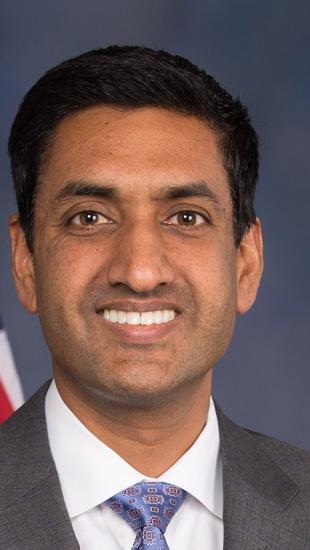
per week, 18-month course, and then those kids get a $65,000 to $85,000 job in technology, but they also learn and are able to be mentors to future students in the program.”
Another 12 students have already begun the next cycle. They will also engage in project development and presentations, with additional mentorship helping them as they potentially earn new opportunities.
“Those students end up getting some high-paying tech jobs,” said JSU Research and Economic Development Vice President Dr. Almesha Campbell to WLBT. “They have skills they won’t necessarily get in the classroom. So, it’s more of a workforce development opportunity that will prepare them for those tech jobs immediately after graduation.”
Khanna plans to expand this venture to more HBCUs, wanting to increase the number of Black people making it to Silicon Valley. He especially wants to help Black professionals secure a great-
er share of the venture capital opportunities growing in the U.S. Understanding how Black Americans have been historically and systemically excluded from workforce opportunities and growth, this initiative is one way to bridge the gap for future leaders in tech.
“We’re producing more wealth than we ever have in the history of this country, and only 1 or 2% of Black Americans are getting venture capital,” added Khanna. “We excluded the Black community from the agricultural revolution. We excluded the Black community from a lot of the Industrial Revolution. Shame on us if the Black community is excluded from the digital revolution.”
This project also seeks to introduce even more HBCU students to STEM, as diversity still lags in the tech sector. According to 2021 data from the Pew Research Center, Black people make up only 9% of all jobs in the tech field. With this in mind, Khanna and JSU are leading a new pipeline for Black talent to grow.
by BlackNews.com
Former Superman actor Dean Cain, best known for playing Clark Kent in the 1990s television series Lois & Clark: The New Adventures of Superman, has announced he will soon join the ranks of U.S. Immigration and Customs Enforcement (ICE). The move aligns him with former President Donald Trump’s hardline approach to immigration enforcement, a stance Cain says he strongly supports. While the superhero he once portrayed was famously an immigrant from another planet, Cain has made it clear that his personal views on immigration are far stricter.
ABC 7 reports that Cain revealed his decision during a Fox News interview, explaining that it began after he shared an ICE recruitment video on social media. The post gained traction, prompting him to connect with ICE officials. “I’m

actually a sworn deputy sheriff and a reserve police officer. I wasn’t part of ICE, but once I put that recruitment video out there, it went crazy,” Cain said. “Now I’ve spoken with some officials over at ICE, and I will be sworn in as an ICE agent ASAP.”
When asked what inspired the move, Cain—who is openly conservative in Hollywood—framed it as a matter of patriotism. “This country was built on patriots stepping up, whether it was popular or not, and doing the right thing. I truly believe this is the right thing,” he told Fox News host Jesse Watters. Cain also criticized the nation’s immigration system as “broken,” urging Congress to act but praising Trump for following through on campaign promises to tighten border and immigration enforcement.
Cain’s announcement comes at a time when ICE has ramped up operations nationwide under the Trump administra-
tion, with hundreds of immigrants being arrested daily. While enforcement is happening across the U.S., a CNN analysis found a stark difference in arrest patterns between states that voted for Trump and those that lean Democratic.
In Republican-leaning states, ICE arrests are more likely to target immigrants already in prisons or jails. In contrast, in blue states, the agency often conducts workplace raids, street arrests, and large-scale sweeps—operations that have sparked protests and public backlash, especially in cities like Los Angeles. Notably, many of those detained in these community arrests have no criminal record. Overall, the data shows ICE has made more arrests in red states than in blue states, particularly in detention facilities, reflecting both the administration’s priorities and the political divide over immigration enforcement in America.
The year 2018 was one of the most rewarding, yet challenging, years of my life.
I was 52 years old and at the top of my game in my legal career and holding a top position in my friend’s Senate campaign for the State of Maryland. It was Day 3 of Early Voting and I was driving around town like a chicken with my head cut off when I got the call from my doctor that the lump they found in my left breast was cancer. As I listened to her tell me I needed to come in and have my right breast biopsied, just for precaution, I remember saying to myself, “Girl, you ain’t got time
to die this year!” Only to find out a week later that I had a different type of cancer in my right breast. I then remember thinking, “No Black Jesus, not the tattas!”

The lump had been found through a routine mammogram in June 2018. My doctors at George Washington Hospital Center were all amazing, from my cancer surgeon and plastic surgeon to my radiologist and hematologist. I had a mastectomy on the left breast to treat my Stage 1A tumor and a lumpectomy followed by nine weeks of daily radiation on the right breast. During this time, my boyfriend, Melvin, was an amazing support. He was so patient and is such a blessing in my life.
Six months later, I started to get my energy back and felt more like my normal self again. I thought to myself, “When you were diagnosed, you were a triple D, now you are a C cup.Girl, you had been wanting a breast reduction and all you had to do was get a little cancer. Look at God, won’t He do it!”
At this point, I realized that God allowed me to survive because He had more work for me to do before leaving this earth, and I chose to laugh through my pain. It was at this point, I decided I wanted to do something that would feed my soul but give back to the world. I decided to be-
come a stand-up comedian! Over the past five years, I’ve worked with comedians I never thought I would meet, let alone share a stage with them. I’ve performed on stages across the country, including the world famous Apollo Theater in Harlem. I’ve been featured in two movies, both which air on Tubi network.
God has shown me there is no limit to what I can accomplish, and if I can help one person laugh through their pain as I did, I’ve done my job.
by Michelle Andrews, KFF Health News
Credit: Towfiqu barbhuiya / Pexels.com
If you want a COVID-19 shot this fall, will your employer’s health insurance plan pay for it? There’s no clear answer. Health and Human Services Secretary Robert F. Kennedy Jr., a longtime anti-vaccine activist, has upended the way Covid vaccines are approved and for whom they’re recommended, creating uncertainty where coverage was routine.
Agencies within HHS responsible for spelling out who should get vaccinated aren’t necessarily in sync, issuing seemingly contradictory recommendations based on age or risk factors for serious disease.
But the ambiguity may not affect your coverage, at least this year.
“I think in 2025 it’s highly likely that the employer plans will cover” the Covid vaccines, said Jeff Levin-Scherz, a primary care doctor who is the population health leader for the management consultancy WTW and an assistant professor at Harvard’s T.H. Chan School of Public Health. They’ve already budgeted for it, “and it would be a large administrative effort to try to exclude coverage for those not at increased risk,” he said.
With so much in flux, it’s important to check with your employer or insurer about coverage policies before you roll up your sleeve.
Here’s what we know so far, and what remains unclear.
Q: How have the recommendations changed?
What used to be straightforward is now much murkier. Last year, the Moderna and Pfizer-BioNTech COVID-19 vaccines were recommended for anyone at least 6 months old.
This year, the recommendation by the Centers for Disease Control and Prevention is narrower. Although the vaccines are broadly recommended for adults 19 and older, they are no longer recommended for healthy pregnant people or for healthy children 6 months through 17 years old.
Kennedy announced the changes in a video in May, citing safety risks for young people and pregnant people as justification.
But his claims have been widely disputed by experts in vaccines, pediatrics, and women’s health. An analysis by FactCheck.org found that the secretary “misrepresented scientific research to make unfounded claims about vaccine safety for pregnant people and children.”
In addition, recently announced changes to the vaccine approval framework have further chipped away at eligibility.
Moderna announced July 10 that the FDA had fully approved its Spikevax COVID-19 vaccine — but approval is restricted to adults 65 and older, and for people from 6 months through 64 years old who are at increased risk of developing a serious case of COVID-19. Two other COVID-19 vaccines expected
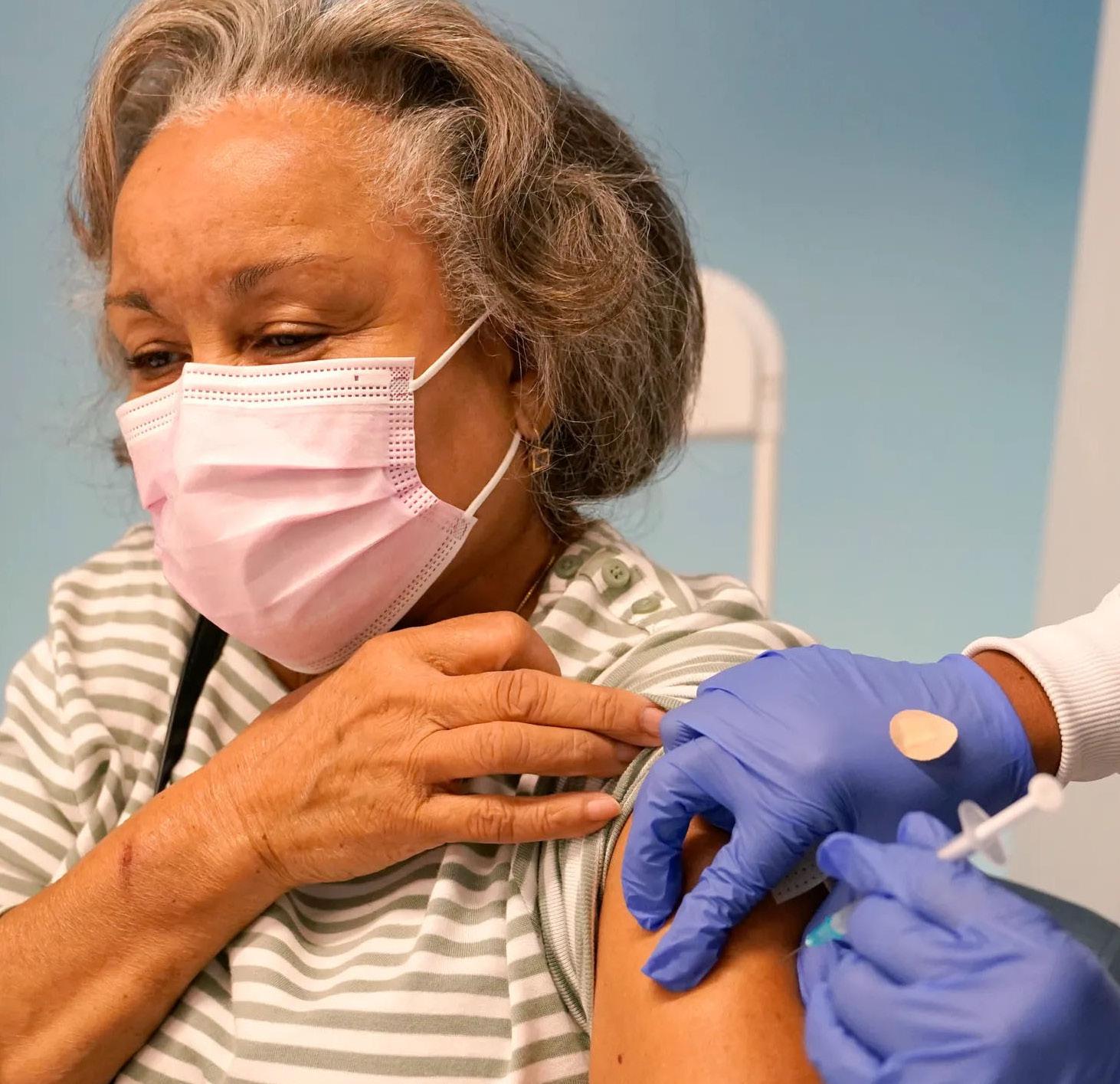
to be available this fall, Novavax’s Nuvaxovid and Moderna’s mNexspike, are also restricted. They are approved for people 65 or older and those 12 to 64 who have underlying health conditions that put them at higher risk of developing severe Covid.
Notably, Pfizer’s Comirnaty Covid vaccine is still approved or authorized for people 6 months of age and older without any restrictions based on risk factors for Covid — at least for now. But the FDA could change that at any time, experts said.
Increasing restrictions “is definitely the direction they are moving,” said Jen Kates, a senior vice president at KFF who authored a KFF analysis of vaccine insurance coverage rules. KFF is a health information nonprofit that includes KFF Health News.
HHS did not provide an on-the-record comment for this article.
Q: How might these changes alter my insurance coverage for the vaccine? That’s the big question, and the answer is uncertain. Without insurance coverage, people could owe hundreds of dollars for the shot.
Most private health plans are required by law to cover recommended vaccines, whether for Covid, measles, or the flu, without charging their members. But that
requirement kicks in after the shots are recommended by a federal panel — the Advisory Committee on Immunization Practices — and adopted by the CDC director, according to the KFF analysis.
The committee hasn’t yet voted on Covid vaccine recommendations for this fall. Its next meeting is expected to occur in August or September.
Still, employers and insurers can opt to cover the vaccines on their own, as many did before the law required them to do so. But they may require people to pay something for it.
In addition, the narrower recommendations from different HHS agencies might result in some health plans declining to pay for certain categories of people to get certain vaccines, experts said.
“I don’t think an employer or insurer would deny coverage,” Kates said. “But they could say: You have to get this product.”
That could mean a 45-year-old with no underlying health conditions raising their Covid risk might have to get the Pfizer shot rather than the Moderna version if they want their health plan to pay for it, experts said.
In addition, up to 200 million people may qualify for the vaccines because they have health conditions such as asthma or diabetes that increase their risk of severe disease, according to a commentary pub-
shared decision-making,” said Amanda Jezek, senior vice president of public policy and government relations at the Infectious Diseases Society of America. There’s no similar allowance for pregnant people. However, even though Kennedy has stated that Covid vaccines are no longer recommended for healthy pregnant people, pregnancy is one of the underlying medical conditions that put people at high risk for getting very sick from Covid, according to the CDC. That could make pregnant people eligible for the shot.
Depending on the stage of someone’s pregnancy, it could be difficult to know whether someone should be denied the shot based on their condition. “This is uncharted territory,” said Sabrina Corlette, co-director of Georgetown University’s Center on Health Insurance Reforms.
Q: How will these changes affect access to the vaccine? Will I still be able to go to the pharmacy for the shot?
“If far fewer are expected to be vaccinated, fewer sites will offer the vaccinations,” Levin-Scherz said. This could be an especially notable hurdle for people looking for pediatric doses of a Covid vaccine, he said.
In addition, pharmacists’ authority to administer vaccines depends on several factors. For example, in some states they can administer shots that have been approved by the FDA, while in others the shots must have been recommended by the ACIP, said Hannah Fish, senior director of strategic initiatives at the National Community Pharmacists Association. Since ACIP hasn’t yet recommended Covid shots for the fall, that could create a speed bump in some states.
lished by FDA officials in the New England Journal of Medicine.
Health care professionals can help people determine whether they qualify for the shot based on health conditions.
Tina Stow, a spokesperson for AHIP, which represents health plans, said in a statement that plans will continue to follow federal requirements for vaccine coverage.
Q: What are the options for people who are pregnant or have children they want to have vaccinated?
Many parents are confused about getting their kids vaccinated, according to a KFF poll released on Aug. 1. About half said they don’t know whether federal agencies recommend healthy children get the vaccine this fall. Among the other half, more said the vaccine is not recommended than recommended.
Meanwhile, Kennedy’s recommendation that healthy children not get vaccinated has a notable caveat: If a parent wishes a child to get a Covid vaccine and a health care provider recommends it, the child can receive it under the “shared clinical decision-making” model, and it should be covered without cost sharing. Some policy experts point out that this is the way care for kids is typically provided anyway.
“Outside of any requirements, vaccines have always been provided through
“Depending on the rules, you still may be able to get the shot at the pharmacy, but they might have to call the physician to send over a prescription,” Fish said. Q: What do these changes mean longterm?
It’s impossible to know. But given Kennedy’s vocal skepticism of vaccines and his embrace of long-disproven theories about connections between vaccines and autism, among other things, medical and public health professionals are concerned those views will shape future policies.
“The recommendation changes that were made with respect to children and pregnant women were not necessarily made in good science,” Corlette said.
It’s already a challenge to convince people they need annual Covid shots, and shifting guidelines may make it tougher, some public health experts warn.
“What’s concerning is that this could even further depress the uptake of the Covid vaccines,” Jezek said.
KFF Health News is a national newsroom that produces in-depth journalism about health issues and is one of the core operating programs at KFF—an independent source of health policy research, polling, and journalism. Learn more about KFF.
Subscribe to KFF Health News’ free Morning Briefing.
Wastewater Treatment Plant Operator (Attendant III): Operates and maintains equipment and processes in a municipal sewage treatment plant. Requires an H.S. diploma or GED. A State of CT Dept. of Energy and Environmental Protection (DEEP) Class III Operators License or higher certification; or a Class III Operator-in-training or higher certification plus three (3) yrs. of experience in the operation of a class II or higher wastewater treatment facility, with one (1) yr. in a supervisory capacity of foreman level or higher. Must possess and maintain a valid driver’s license. Wages: $ 32.24 to $ 36.79 hourly. The Town offers an excellent fringe benefits package that includes pension plan, paid sick and vacation time, individual and family medical insurance, life insurance, 13 paid holidays, and deferred compensation plan. The closing date will be July 22, 2025. To apply online, please visit: www.wallingfordct.gov/government/ departments/human-resources/. Applications are also available at the Department of Human Resources located in Room #301 of the Town Hall, 45 South Main Street, Wallingford, CT 06492. Phone: (203) 294-2080; Fax: (203) 294-2084. EOE
LBR Mechanical Corp is seeking P2 plumbing mechanics, jour¬neymen and helpers for a construction project located in Bridgeport, CT. Experience in plumbing/heating, construction and roughing a plus. Will train the right candidates. Driver’s license and proof of citizenship required.
Please call 914-276-1493 for an application to start your new career.
Extremely fast paced petroleum company is looking for a full time (which includes on call and weekend coverage) detail oriented experiencedDispatcher. A strong logistics background and a minimum of one year previous experience is required. Send resume to: HR Manager, P.O. Box 388, Guilford, CT. 06437. Email: HRDEPT@eastriverenergy. com
*An Affirmative Action/Equal Opportunity Employer, including Disabled and Veterans*
The Glendower Group is seeking proposals from firms for project management services for a Project located at 64-66 Wasson Avenue. New York. A complete copy of the requirement may be obtained from Elm City’s Vendor Collaboration Portal https://newhavenhousing.cobblestonesystems.com/gateway beginning on
Wednesday, July 16, 2025, at 3:00PM.

THE HOUSING AUTHORITY OF THE CITY OF NORWALK, CT IS REQUESTING PROPOSALS FROM QUALIFIED CONSULTANT FOR STRATEGIC PLANNING SERVICE. TO OBTAIN A COMPLETE COPY OF THE REQUEST FOR PROPOSAL DOCUMENTS, CONTACT GUILLERMO BENDANA, PROCUREMENT SPECIALIST AT GBENDA@NORWALKHA.ORG PROPOSALS ARE DUE AT 2:00 P.M. ON 08/18/2025.
NORWALK HOUSING IS AN EQUAL OPPORTUNITY EMPLOYER. ADAM BOVILSKY, EXECUTIVE DIRECTOR.
Architectural Services-64-66 Wasson Avenue, Lackawanna, New York., (Section 141, 43, Block 2, lot 20,21,22,23,24,25,40,41,42,43,44,45,46,47,1,)
The Glendower Group is currently seeking qualifications from qualified firms for Architectural Services. A complete copy of the requirement may be obtained from Elm City’s Vendor Collaboration Portal https://newhavenhousing.cobblestonesystems.com/gateway beginning on
Wednesday, July 16, 2025, at 3:00PM.

Ducci Electrical Contractors, Inc. seeks a friendly, organized, and professional Front Desk receptionist. Must be reliable, have strong communication skills, and able to multi-task. Ability to answer multi-line phones system. This is a full-time position. Send resume to Ducci Electrical Contractors, Inc. 74 Scott Swamp Rd. Farmington, CT 06032 or via email athumanresources@duccielectrical.com. An affirmative action equal opportunity employer.
Wastewater Treatment Plant Operator (Attendant II): Operates and maintains equipment and processes in a municipal sewage treatment plant. Requires an H.S. diploma or GED. A State of Connecticut DEEP Class II Operator or higher certification; or a Class II Operator-in-Training or higher certification. Wages: $28.44 to $33.89. The Town offers an excellent fringe benefits package that includes pension plan, paid sick and vacation time, individual and family medical insurance, life insurance, 13 paid holidays, and deferred compensation plan. The closing date will be August 12, 2025. To apply online, please visit: www. wallingfordct.gov/government/departments/human-resources/. Applications are also available at the Department of Human Resources located in Room #301 of the Town Hall, 45 South Main Street, Wallingford, CT 06492. Phone: (203) 294-2080; Fax: (203) 294-2084. EOE
Owners Representative Services for Design Review and Construction Administration 360 Management Group is seeking proposals from qualified firms to serve as an Owner’s Representative to assist in the oversight of design and construction for one or more of its affordable housing and mixed-use real estate development projects.. A complete copy of the requirement may be obtained from Elm City’s Vendor Collaboration Portal https://newhavenhousing.cobblestonesystems.com/gateway beginning on
Monday, July 28, 2025, at 3:00PM.
The Town of Wallingford Water and Sewer Divisions is seeking a highly qualified engineer to provide responsible engineering work in the preparation and maintenance of accurate, utility design drawings, specifications and location records. Applicants should possess a B.S. degree in civil, mechanical, or environmental engineering plus 2 years of responsible experience in the water and sewer utility field or underground design and construction of pipelines (storm drain or gas mains), or an equivalent combination of education and qualifying experience substituting on a year-for-year basis. You must possess and maintain a valid State of Connecticut Driver’s License. An Engineer-in-Training (EIT) or Fundamentals in Engineering (FE) certificate is desirable. Salary: $75,890 to $96,227 annually. The Town offers an excellent fringe benefits package that includes a pension plan, generous paid sick and vacation time, medical/dental insurance, life insurance, 13 paid holidays, and a deferred compensation plan. Applications will be accepted until the position is filled. To apply online please visit: www.wallingfordct.gov/government/departments/human-resources/. Applications are also available at the Department of Human Resources located in Room #301 of the Town Hall, 45 South Main Street, Wallingford, CT 06492. Phone: (203) 294-2080; Fax: (203) 294-2084. EOE
Ducci Electrical Contractors, Inc. seeks a friendly, organized, and professional Front Desk receptionist. Must be reliable, have strong communication skills, and able to multi-task. Ability to answer multi-line phones system. This is a full-time position. Send resume to Ducci Electrical Contractors, Inc. 74 Scott Swamp Rd. Farmington, CT 06032 or via email athumanresources@duccielectrical.com. An affirmative action equal opportunity employer.
Performs tasks in facilitating the purchase of a wide variety of materials, supplies, equipment and professional services. The position requires an associate’s degree in business administration and 3 years purchasing experience. A bachelor’s degree in business administration may substitute for 2 years of the work experience. $32.08 - $38.98 hourly, (contract currently under negotiations). The Town offers an excellent fringe benefits package that includes a pension plan, generous paid sick and vacation time, medical/ dental insurance, life insurance, 13 paid holidays, and a deferred compensation plan. To apply online by the closing date of August 4, 2025, please visit: www.wallingfordct.gov/government/departments/human-resources/. Applications are also available at the Department of Human Resources located in Room #301 of the Town Hall, 45 South Main Street, Wallingford, CT 06492. Phone: (203) 294-2080; Fax: (203) 294-2084. EOE

The Glendower Group is soliciting sealed bids for the Electrical Renovations at McConaughy Terrace. A complete copy of the requirement may be obtained from Elm City’s Vendor Collaboration Portal https://newhavenhousing.cobblestonesystems. com/gateway beginning on
Monday,
The Town of Wallingford Sewer Division is seeking a skilled manager to provide responsible technical, administrative and supervisory work involving the operation and maintenance of wastewater pumping stations and the sanitary sewer collections system. Applicants should possess a B.S. degree in civil engineering, environmental engineering or environmental science, mechanical engineering or other engineering plus 4 years of experience in wastewater collection and in the repair and maintenance of mechanical and motorized equipment (pump stations), or an equivalent combination of education and qualifying experience substituting on a year-for-year basis. Must possess and maintain a valid State of Connecticut Commercial Driver’s License (CDL) Class B at the time of appointment. Must possess and maintain, or be able to obtain in the probation period, CDL tanker and air brake endorsements. Must possess and maintain, or be able to obtain in the probation period, a NEWEA certification as a Collection System Operator Grade II or higher. Salary: $87, 357 to $110, 894 annually plus on-call pay when assigned. The Town offers an excellent fringe benefits package that includes pension plan, generous paid sick and vacation time, medical/dental insurance, life insurance, 13 paid holidays, and a deferred compensation plan. To apply online by the closing date of July 29, 2025, please visit: www.wallingfordct.gov/government/departments/human-resources/. Applications are also available at the Department of Human Resources located in Room #301 of the Town Hall, 45 South Main Street, Wallingford, CT 06492. Phone: (203) 294-2080; Fax: (203) 294-2084. EOE
The Town of Wallingford Water and Sewer Divisions is seeking a highly qualified engineer to provide responsible engineering work in the preparation and maintenance of accurate, utility design drawings, specifications and location records. Applicants should possess a B.S. degree in civil, mechanical, or environmental engineering plus 2 years of responsible experience in the water and sewer utility field or underground design and construction of pipelines (storm drain or gas mains), or an equivalent combination of education and qualifying experience substituting on a year-for-year basis. You must possess and maintain a valid State of Connecticut Driver’s License. An Engineer-in-Training (EIT) or Fundamentals in Engineering (FE) certificate is desirable. Salary: $75,890 to $96,227 annually. The Town offers an excellent fringe benefits package that includes a pension plan, generous paid sick and vacation time, medical/dental insurance, life insurance, 13 paid holidays, and a deferred compensation plan. Applications will be accepted until the position is filled. To apply online please visit: www.wallingfordct.gov/government/ departments/human-resources/. Applications are also available at the Department of Human Resources located in Room #301 of the Town Hall, 45 South Main Street, Wallingford, CT 06492. Phone: (203) 2942080; Fax: (203) 294-2084. EOE
by Daniel Chang and Sam Whitehead, KFF Health News am
MIAMI — Republican lawmakers in the 10 states that refused the Affordable Care Act’s Medicaid expansion for over a decade have argued their conservative approach to growing government programs would pay off in the long run.
Instead, the Republican-passed budget law that includes many of President Donald Trump’s priorities will pose at least as big a burden on patients and hospitals in the expansion holdout states as in the 40 states that have extended Medicaid coverage to more low-income adults, hospital executives and other officials warn.
For instance, Georgia, with a population of just over 11 million, will see as many people lose insurance coverage sold through ACA marketplaces as will California, with more than triple the population, according to estimates by KFF, a health information nonprofit that includes KFF Health News.
The new law imposes additional paperwork requirements on Obamacare enrollees, slashes the time they have each year to sign up, and cuts funding for navigators who help them shop for plans. Those changes, all of which will erode enrollment, are expected to have far more impact in states like Florida and Texas than in California because a higher proportion of residents in non-expansion states are enrolled in ACA plans.
The budget law, which Republicans called the “One Big Beautiful Bill,” will cause sweeping changes to health care across the country as it trims federal spending on Medicaid by more than $1 trillion over the next decade. The program covers more than 71 million people with low incomes and disabilities. Ten million people will lose coverage over the next decade due to the law, according to the nonpartisan Congressional Budget Office.
Many of its provisions are focused on the 40 states that expanded Medicaid under the ACA, which added millions more low-income adults to the rolls. But the consequences are not confined to those states. A proposal from conservatives to cut more generous federal payments for people added to Medicaid by the ACA expansion didn’t make it into the law.
“Politicians in non-expansion states should be furious about that,” said Michael Cannon, director of health policy studies at the Cato Institute, a libertarian think tank.
The number of people losing coverage could accelerate in non-expansion states if enhanced federal subsidies for Obamacare plans expire at the end of the year, driving up premiums as early as January and adding to the rolls of uninsured. KFF estimates as many as 2.2 million people could become uninsured just in Florida, a state where lawmakers
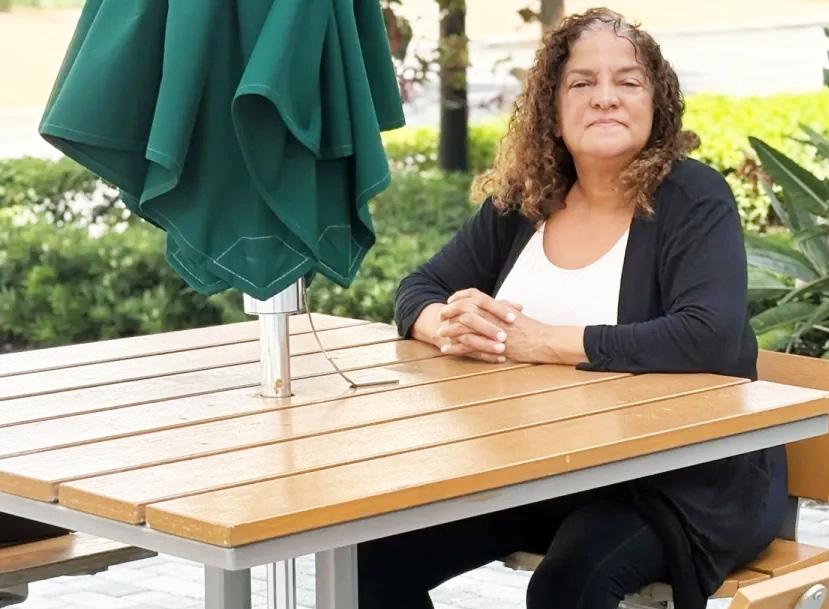
refused to expand Medicaid and, partly as a result, now leads the nation in ACA enrollment.
For people like Francoise Cham of Miami, who has Obamacare coverage, the Republican policy changes could be life-altering.
Before she had insurance, the 62-yearold single mom said she would donate blood just to get her cholesterol checked. Once a year, she’d splurge for a wellness exam at Planned Parenthood. She expects to make about $28,000 this year and currently pays about $100 a month for an ACA plan to cover herself and her daughter, and even that strains her budget.
Cham choked up describing the “safety net” that health insurance has afforded her — and at the prospect of being unable to afford coverage if premiums spike at the end of the year.
“Obamacare has been my lifesaver,” she said.
If the enhanced ACA subsidies aren’t extended, “everyone will be hit hard,” said Cindy Mann, a health policy expert with Manatt Health, a consulting and legal firm, and a former deputy administrator for the Centers for Medicare & Medicaid Services.
“But a state that hasn’t expanded Medicaid will have marketplace people enrolling at lower income levels,” she said. “So, a greater share of residents are reliant on the marketplace.”
Though Republican lawmakers may try to cut Medicaid even more this year, for now the states that expanded Medicaid largely appear to have made a
smart decision, while states that haven’t are facing similar financial pressures without any upside, said health policy experts and hospital industry observers. KFF Health News reached out to the governors of the 10 states that have not fully expanded Medicaid to see if the budget legislation made them regret that decision or made them more open to expansion. Spokespeople for Republican Gov. Henry McMaster of South Carolina and Republican Gov. Brian Kemp of Georgia did not indicate whether their states are considering Medicaid expansion.
Brandon Charochak, a spokesperson for McMaster’s office, said South Carolina’s Medicaid program focuses on “low-income children and families and disabled individuals,” adding, “The state’s Medicaid program does not anticipate a large impact on the agency’s Medicaid population.”
Enrollment in ACA marketplace plans nationwide has more than doubled since 2020 to 24.3 million. If enhanced subsidies expire, premiums for Obamacare coverage would rise by more than 75% on average, according to an analysis by KFF. Some insurers are already signaling they plan to charge more.
The CBO estimates that allowing enhanced subsidies to expire will increase the number of people without health insurance by 4.2 million by 2034, compared with a permanent extension. That would come on top of the coverage losses caused by Trump’s budget law.
“That is problematic and scary for us,” said Eric Boley, president of the Wyoming Hospital Association.
He said his state, which did not ex-
other health institutions from $500 million a year to $1.5 billion a year. He said higher rates helped Mississippi’s rural hospitals stay open.
“That payment program has just been a lifeline,” Roberson said.
The budget law includes a $50 billion fund intended to insulate rural hospitals and clinics from its changes to Medicaid and the ACA. But a KFF analysis found it would offset only about one-third of the cuts to Medicaid in rural areas.
Trump encouraged Florida, Tennessee, and Texas to continue refusing Medicaid expansion in his first term, when his administration gave them an unusual 10year extension for financing programs known as uncompensated care pools, which generate billions of dollars to pay hospitals for treating the uninsured, said Allison Orris, director of Medicaid policy for the left-leaning think tank Center on Budget and Policy Priorities.
“Those were very clearly a decision from the first Trump administration to say, ‘You get a lot of money for an uncompensated care pool instead of expanding Medicaid,’” she said.
pand Medicaid, has a relatively small population and hasn’t been the most attractive for insurance providers — few companies currently offer plans on the ACA exchange — and he worried any increase in the uninsured rate would “collapse the insurance market.”
As the uninsured rate rises in non-expansion states and the budget law’s Medicaid cuts loom, lawmakers say state funds will not backfill the loss of federal dollars, including in states that have refused to expand Medicaid.
Those states got slightly favorable treatment under the law, but it’s not enough, said Grace Hoge, press secretary for Kansas Gov. Laura Kelly, a Democrat who favors Medicaid expansion but who has been rebuffed by Republican state legislators.
“Kansans’ ability to access affordable healthcare will be harmed,” Hoge said in an email. “Kansas, nor our rural hospitals, will not be able to make up for these cuts.”
For hospital leaders in other states that have refused full Medicaid expansion, the budget law poses another test by limiting financing arrangements states leveraged to make higher Medicaid payments to doctors and hospitals.
Beginning in 2028, the law will reduce those payments by 10 percentage points each year until they are closer to what Medicare pays.
Richard Roberson, president of the Mississippi Hospital Association, said the state’s use of what’s called directed payments in 2023 helped raise its Medicaid reimbursements to hospitals and
Those funds are not affected by Trump’s new tax-and-spending law. But they do not help patients the way insurance coverage would, Orris said. “This is paying hospitals, but it’s not giving people health care,” she said. “It’s not giving people prevention.”
States such as Florida, Georgia, and Mississippi have not only turned down the additional federal funding that Medicaid expansion brings, but most of the remaining non-expansion states spend less than the national average per Medicaid enrollee, provide fewer or less generous benefits, and cover fewer categories of low-income Americans.
Mary Mayhew, president of the Florida Hospital Association, said the state’s Medicaid program does not adequately cover children, older people, and people with disabilities because reimbursement rates are too low.
“Children don’t have timely access to dentists,” she said. “Expectant moms don’t have access nearby to an OBGYN. We’ve had labor and delivery units close in Florida.”
She said the law will cost states more in the long run.
“The health care outcomes for the individuals we serve will deteriorate,” Mayhew said. “That’s going to lead to higher cost, more spending, more dependency on the emergency department.”
KFF Health News is a national newsroom that produces in-depth journalism about health issues and is one of the core operating programs at KFF—an independent source of health policy research, polling, and journalism. Learn more about KFF.
by Taylor Lofton, BlackHealthMatters.com
We may become older and wiser, but our immune systems are more likely to be weaker than they once were. People aged 65 and above are at the highest risk of developing serious flu complications. A healthy adult 65 and older is 10x more likely to be hospitalized with pneumococcal pneumonia.
This makes it easier for infections to occur, ultimately leading to more severe symptoms. Fortunately, staying up to date on vaccines can help protect seniors from many preventable illnesses and complications.
Here’s an overview of the recommended vaccines for older adults in 2025:
Ages 50–64
• COVID-19: Updated vaccine recommended for all adults 18+ (annual 20242025 COVID-19 vaccine).
• Flu: Annual vaccine.
• Pneumococcal pneumonia: Recommended if you have never received it before and you are 50+
• Shingles: Two doses for all adults 50+.
• Td/Tdap: Td (tetanus, diphtheria) booster every 10 years, or Tdap once if you never had it as a child; Tdap also during each pregnancy.
Ages 60 and Up
• COVID-19: At 65+, recommended to receive 2 doses of any 2024-25

COVID-19 vaccine, 6 months apart.
• Flu: Annual vaccine.
• Pneumococcal: Recommended if you have never received it before and you are 50+
• Shingles: Two doses for adults 50+.
• RSV: Adults 60–74 are at increased risk, and all adults 75+ should get one dose.
• Td/Tdap: Booster every 10 years; Tdap once if never received as a child; Tdap in each pregnancy.
Other Guidance
• If you were born before 1957, you are assumed to be immune to measles, mumps, and rubella and do not need the MMR vaccine.
• The COVID-19 vaccine is still recommended for all adults 18 and older, especially since protection decreases over time and new variants can appear (this is why the 2024-2025 vaccine is suggested).
Tips if You Can’t Find Your Vaccine Records
• Ask previous healthcare providers, schools, or jobs for records.
• Check your state’s immunization registry.
• If you cannot find your records, it is safe to get vaccines again; extra doses are not harmful.
Addressing Common Concerns
The CDC continues to recommend immunizations for adults, especially seniors, to prevent severe disease.
According to Johns Hopkins Bloomberg School of Public Health, RSV vaccines are now available for adults 60 and older, with three approved options in the U.S.
(Arexvy, Abrysvo, and mResvia). One dose protects against severe RSV for up to two years and is recommended for all adults 75+, as well as adults 60–74 who are at increased risk.
You may have heard conflicting information about vaccines from public figures and in the news. For example, Health and Human Services Secretary Robert F. Kennedy Jr. (RFK Jr.) has questioned the safety or necessity of certain vaccines. In 2025, Secretary Kennedy replaced members of a key CDC vaccine advisory committee with individuals known for vaccine skepticism. This move has been criticized by former committee members and many in the scientific community. They warn that it could undermine rigorous, evidence-based review and public confidence in vaccinations.
Despite these policy shifts, leading medical organizations, including the CDC, continue to strongly recommend age-appropriate vaccinations for adults and seniors. Research consistently shows vaccines are safe and help prevent serious disease.
The COVID-19 vaccine remains on the recommended schedule for adults because protection decreases over time and new variants appear.

They are using a range of breakthrough treatments that combine supplements, serums, microneedling, red light therapy, lasers and getting results.
Margaret Wilson, BlackHealthMatters.com
Now, when we experience hair loss, Black dermatologists are researching and offering possible solutions. We talked to four about the latest options, from supplements to serums, lasers, and more. Read on to learn more about the breakthrough treatments they are working on, who they might work best for, and what’s on the horizon.
Bright Solutions with Laser Therapy
For many years, Dr. Jeanine Downie of Image Dermatology® P.C. has been at the forefront of hair growth advancements, making significant contributions to the field through her expertise and innovative treatments.
She has seen breakthrough after breakthrough over the last ten years, particularly with the introduction of supplements like Nutrafol and super products like Lambdapil (a hair density shampoo and lotion that revitalizes and nourishes thinning hair, most effective when paired with the Nutrafol) DefanAge®. This 150K hair serum thickens the density of the hair follicle.
Dr. Downie has also championed KeraLase™, a cutting-edge hair restoration therapy that uses Lutronic™ LaseMD® Ultra laser technology and KeraFactor® serum application. The Lutronic LaseMD® laser opens up the hair follicles on the scalp, which helps to optimize absorption. This prepares the skin for the KeraFactor® hair growth serum, which contains growth factors and proteins that promote thicker, fuller hair.
It has shown effectiveness for several types of hair loss, including androgenetic alopecia (female pattern baldness), traction alopecia, and stress-related hair loss. Additionally, KeraLase™ is more expensive than other treatments because of the laser component, running approximately $1,000 per treatment session.
Beyond the in-office treatments, Dr. Downie stresses the importance of practicing “good scalp and hair health habits” to see maximum results. Consultation is key. Dr. Downie evaluates
each patient individually to determine if laser therapy is the best option (or at all) and if other therapies or a combination of treatments (laser, medications, topical) is the best approach.
Dr. Valerie Callender, Medical Director and Founder of Callender Dermatology and Cosmetic Center, is known for her sensitive and innovative approach to managing hair loss in African American women. Widely respected for her leadership role with the Skin of Color Society, Dr. Callender shares that a necessary breakthrough in getting to the root cause of hair loss in our community is
Dr. Callender considers new developments in research critical to understanding patients’ genetic predispositions, which is critical to treating hair loss. Next comes treatment. Research partnered with new diagnostic tools, like dermatoscopy, has helped determine what type of hair loss a patient is experiencing. This non-invasive tool, also known as a Trichoscope, examines the scalp and hair shaft closely to identify the specific type of hair loss or alopecia so that the proper treatment can follow. Lastly, there’s been an uptick in Doctors pairing oral minoxidil with topical minoxidil prescriptions for maximum results.
Dr. Callender is dedicated to demystifying hair loss by assuring her patients that treatment is available. “Hair loss can be treated with the diagnosis approach of a Board-certified Dermatologist; don’t give up.”
Dr. Crystal U. Aguh, Associate Professor of Dermatology and Director of the Ethnic Skin Program at Johns Hopkins Department of Dermatology, is known for her profound research and numerous prestigious awards, including those from the Skin of Color Society. With CCCA being the type of hair loss that affects black women almost exclu-

sively, there have been some exciting breakthroughs and research happening over the past 5 to 10 years, shares Dr. Aguh.
Supplements that have shown some effectiveness in men include Saw Palmetto, a male hormone blocker. However, it is still unclear how effective this supplement is in women. However, data supports the use of Rosemary Oil, proven to be as effective as 2% Minoxidil (generic name Rogaine), for non-scarring hair loss.
If you’re also looking for tech-savvy solutions, red light therapy might be an option to consider after all measures have been taken to preserve the overall health of your hair. Dr. Aguh advises that while these devices may stimulate hair growth, doing your homework first is key.
Overall, it’s important to note that everyone’s hair differs, and individual results may vary. It’s always a good idea to consult first with a board-certified dermatologist.
Dr. Achiamah Osei-Tutu & Master Natural Hair Care Expert Diane C. Bailey – Who wouldn’t want their own dream team dedicated to your hair health? That’s the superpower of the partnership between Dr. Achiamah Osei-Tutu of Osei-Tutu Dermatology and Master Hair Care Expert Diane C. Bailey.
Dr. Osei-Tutu has also seen successful results with micro-needling treatments and laser-assisted delivery of medications, such as KeraLase™ and Alma TED, an ultrasound-based device offering a non-invasive treatment for hair growth.
However, after diagnosis, Dr. Osei-Tutu found that her patients needed support with the hair care part of their journey. “We wanted to [recommend stylists] who were knowledgeable about different diagnoses and non-tension hairstyles and had time to listen and care,” notes Dr. Osei-Tutu. That’s where Diane C. Bailey comes in.
Diane C. Bailey supports her clients in a private setting by teaching them the fundamentals of their hair care process. Scalp health AND hair health is Key! Bailey’s work is focused on cleansing, hydrating, and moisturizing the hair and providing a safe space for clients to share, build a trusted relationship, and collaborate on safe yet creative ways to protect and style their hair.
The dynamic duo also recently led a fireside chat at the Rooted in Wellness event hosted by Mane Moves, sharing their insights, resources, and invaluable advice to hair loss patients.
Take inspiration from these dermatology experts doing the work, making an impact in hair loss prevention and treatment and making it more inclusive.
Whether you are experiencing hair loss or simply looking for ways to keep your hair healthy, remember that knowledge is power, and the only way to embrace our personal hair journeys confidently is with the proper tools from trusted professionals.

by Dominique Lambright, BlackDoctor.org
What Is Happening With the Medicaid Cuts?
The sweeping “One Big, Beautiful Bill”—recently signed into law—ushers in nearly one trillion in Medicaid cuts over the next decade, marking the program’s most drastic reduction ever. These cuts tighten eligibility, impose co-pays, and restrict retroactive coverage, undermining access and care for the most vulnerable.
Nursing homes, which serve predominantly Medicaid-dependent residents, stand to feel the greatest shock: 63 percent of residents rely on Medicaid, and proposed cuts deeply jeopardize facility finances. In fact, 579 facilities are at elevated risk of closure, already operating with slim margins, low occupancy, and a heavy reliance on Medicaid funding.
In 2022, Medicaid covered $255 billion in long-term care—yet cuts to “provider taxes” that enable states to bolster reimbursements could dismantle more than 60 percent of nursing home funding. The result: fewer beds, reduced staffing, and dangerous strains on caregiving and family systems.
Is This Affecting Our People?
For Black, Brown, and low-income elders—who already face systemic inequities—these cuts threaten survival and dignity. With over two-thirds of nursing home residents dependent on Medicaid, cuts disrupt their only path to care.
Recent surveys underscore the reality: 92 percent of nursing home providers express severe concern, with over 25 percent indicating closures and 58 percent considering staffing reductions due to Medicaid cutbacks. These cuts also risk pushing millions out of home- and community-based services, ultimately forcing those who value aging in place into institutionalization.
The workforce is crumbling, too. Already underpaid, many direct-care workers are hit with layoffs or wage cuts, and nearly 27 percent of women workers under 65 rely on Medicaid for their own healthcare.
The stakes are severe: closures of nursing homes accelerate “nursing-home deserts,” especially in rural areas. Families are burdened with a drain on savings, unpaid caregiving, and emotional distress.
1. Prioritize Preventive Health Measures to Reduce Long-Term Care Dependency
Investing in preventive health services—chronic disease management, rehabilitation, mobility and fall prevention—can reduce reliance on institutional care. Research shows physical rehabilitation in long-term settings improves strength, mood, balance, and memory among elders.
Programs like PACE (Program of All-Inclusive Care for the Elderly) highlight
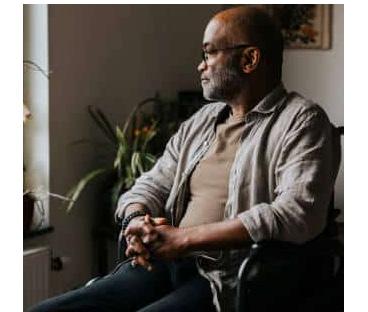
models enabling seniors to stay independent with comprehensive medical and social support in community settings.
2. Develop Training Pipelines for a Diverse and Skilled Elder Care Workforce
A skilled and culturally competent eldercare workforce is critical. Coalitions like the Eldercare Workforce Alliance work to expand geriatrics training, ensure fair wages, and uplift the neglected direct-care sector.
Public funding for such professional pipelines would ensure providers reflect and honor the cultures of the residents they serve, while also retaining staff through improved compensation and growth opportunities.
3. Create Resident Advocacy Boards to Inform Policy from the Ground Up
Residents and families must be central to policy conversations. Advocacy boards can channel lived experience into legislation and operational reforms, ensuring elder voices guide decisions about budgets, care models, and racial equity in access and treatment.
4. Amplify Resident Voices Through Legislative Testimony and Community Engagement
Broad-based civic participation— through testimony, storytelling campaigns, and alliances—can humanize the
brings urgency to the halls of power.
Community-led movements—like the ROAR campaign (“Respect, Oversight, Advocacy, Reform”) launched by the filmmaker of the Amazon exposé on institutional elder neglect—are amplifying public awareness and pushing for systemic reform.
5. Create Nonprofit, Community-Based Elder Care Homes
We must invest in alternatives to traditional institutional care. Models like the Green House Project, with smaller, homelike environments fostering autonomy and dignity, have yielded better social and mental well-being for elders.
Publicly supported, nonprofit elder-care homes rooted in communities can deliver high-quality care with cultural sensitivity, cost efficiency, and human-centered design.
RELATED: The “Big Beautiful Bill” Is Anything But A Wake-Up Call for Health Justice
Why These Strategies Matter
1. Preventive Care Protects Health and Autonomy
Preventive health measures are more than just cost-saving tools — they are life-preserving interventions that keep
3. Resident-Led Policy Means Real Accountability
Too often, nursing home policy is made in boardrooms and legislative chambers far removed from the day-to-day lives of residents. Creating Resident Advocacy Boards shifts that dynamic by bringing the people most affected into the decision-making process.
This isn’t just symbolic — residents and families know exactly where care falls short and where resources are wasted. Their input can shape policies that address racial inequities in treatment, improve food and activities to reflect cultural traditions, and hold facilities accountable when they fail to meet standards.
4. Public Engagement Builds Political Will
We know Medicaid cuts don’t happen in a vacuum — they happen when lawmakers believe the public won’t notice or care. Amplifying resident voices through testimony, storytelling, and grassroots campaigns humanizes what would otherwise be treated as “budget numbers.”
When a daughter shares how Medicaid-funded staff helped her mother recover from a stroke, or when an elder describes losing the only nurse who spoke their native language, policymakers can’t hide behind spreadsheets. Storytelling transforms policy from abstract to urgent, mobilizing communities to demand protection of vital programs.
elders in control of their bodies and choices. Chronic illnesses like diabetes, hypertension, and arthritis — which disproportionately impact Black elders due to decades of health inequity — often become disabling only when they’re left unmanaged.
By prioritizing screenings, mobility support, mental health care, and rehabilitation, we can delay or even prevent the need for institutional care altogether. This not only reduces strain on nursing homes but also affirms elders’ right to age in place within their communities, surrounded by familiarity, culture, and family.
You can’t have quality elder care without a stable, well-trained, and fairly paid workforce. Cuts to Medicaid often mean cutting wages or staff hours, creating dangerous resident-to-staff ratios. The burden falls hardest on direct-care workers — disproportionately women of color — who already earn poverty wages despite doing physically and emotionally demanding work.
When we invest in training pipelines and fair compensation, we aren’t just “staffing up” — we’re creating career paths that reflect the dignity of the work. And when workers reflect the racial, cultural, and linguistic backgrounds of the residents, trust grows and care outcomes improve. Elders feel seen, respected, and safe.
5. Community-Based Care Models
Break the Cycle of Neglect
Traditional, large-scale nursing homes can feel cold, impersonal, and even dehumanizing. For Black and Brown elders — who have endured lifetimes of systemic neglect — these environments often echo other institutional harms.
Nonprofit, community-based elder care homes flip that model. They are smaller, more personal, and rooted in the local culture. Meals can reflect traditional cuisines. Staff are often neighbors or community members. Decision-making is closer to the people it serves. These homes also tend to reinvest resources locally rather than funneling profits to corporate chains. By creating places where elders are not just housed, but honored, we change what aging looks like in America — from a warehouse model to a community-centered one.
The Medicaid cuts now unfolding threaten a generation of Americans, especially elderly members of historically marginalized communities. Behind the numbers are real people—grandmothers, parents, elders yearning to remain seen, cared for, and dignified.
But we are not helpless. Through focused investments in prevention, workforce development, advocacy, community care models, and legislative engagement, we can build a future where Medicaid is not withdrawn from our elders but strengthened by their voices and needs.

